Yaesu Musen 30493X20 Handheld Marine Transceiver with WX User Manual
Yaesu Musen Co., Ltd. Handheld Marine Transceiver with WX
User Manual
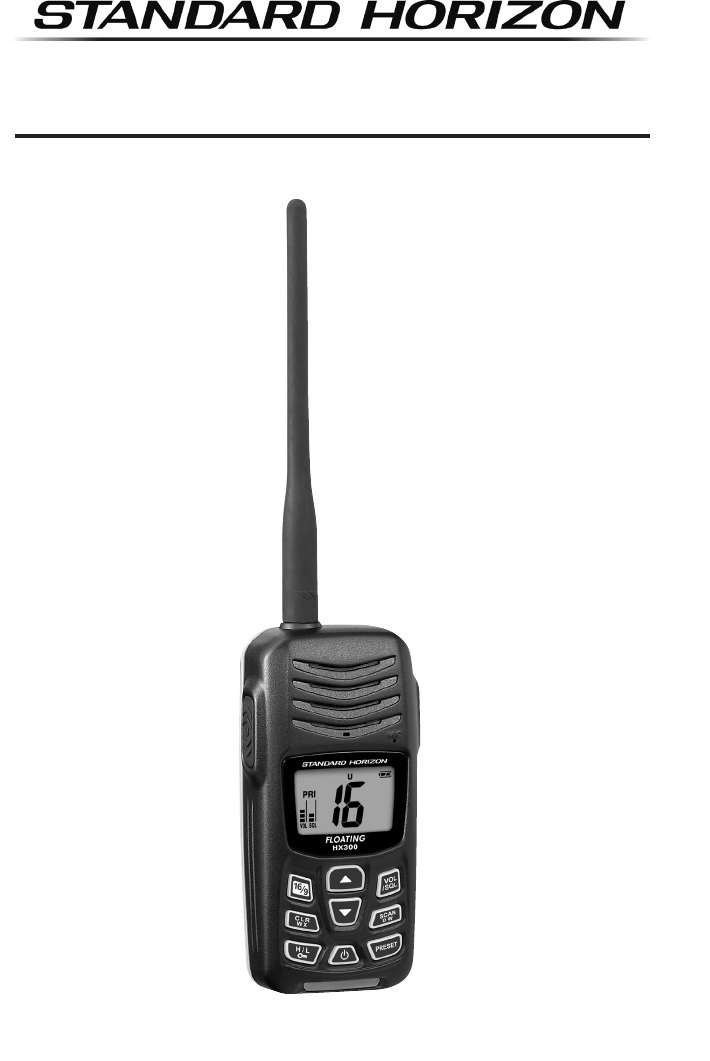
Page 1HX300
HX300
Floating VHF FM Marine Transceiver
Owner’s Manual
FCC ID: K6630493X20 / IC: 511B-303493X20
Vertex Standard Co.,Ltd.

HX300Page 2
TABLE OF CONTENTS
Quick Reference Guide .................................................................................................................................... 3
1. GENERAL INFORMATION ........................................................................................................................ 4
1.1 INTRODUCTION............................................................................................................................ 4
1.2 SAFETY INFORMATION .............................................................................................................. 5
2. ACCESSORIES .......................................................................................................................................... 6
2.1 PACKING LIST .............................................................................................................................. 6
2.2 OPTIONS ....................................................................................................................................... 6
3. ABOUT THIS RADIO ................................................................................................................................ 7
3.1 ABOUT THE VHF MARINE BAND ............................................................................................ 7
3.2 ABOUT WATER RESISTANCE ................................................................................................... 7
3.3 DISTRESS AND HAILING (CHANNEL 16) ................................................................................ 7
3.4 CALLING ANOTHER VESSEL (CHANNEL 16 OR 9) ............................................................... 8
3.5 OPERATING ON CHANNEL 13 .................................................................................................. 9
3.6 OPERATING ON CHANNEL 67 .................................................................................................. 9
3.7 SIMPLEX / DUPLEX CHANNEL USE .......................................................................................... 9
4. GETTING STARTED................................................................................................................................ 10
4.1 RADIO CARE ............................................................................................................................... 10
4.2 BATTERIES AND CHARGERS .................................................................................................. 10
4.2.1 BATTERY SAFETY ......................................................................................................... 10
4.2.2 BATTERY INSTALLATION / REMOVAL .......................................................................... 12
4.2.3 BATTERY CHARGING .................................................................................................... 12
4.3 BELT CLIP INSTALLATION / REMOVAL ................................................................................... 13
HAND STRAP INSTALLATION .................................................................................................. 13
4.4 INSTALLATION OF OPTION ..................................................................................................... 14
4.3.1 FBA-44 ALKALINE BATTERY CASE ............................................................................ 14
5. CONTROLS AND INDICATORS ............................................................................................................ 15
5.1 CONTROLS AND SWITCHES ................................................................................................... 15
5.2 LCD INDICATORS ...................................................................................................................... 18
6. BASIC OPERATION ................................................................................................................................ 20
6.1 PROHIBITED COMMUNICATIONS ............................................................................................ 20
6.2 INITIAL SETUP ........................................................................................................................... 20
6.3 RECEPTION ................................................................................................................................ 20
6.4 TRANSMISSION .......................................................................................................................... 21
6.4.1 TRANSMIT TIME-OUT TIMER (TOT) .............................................................................. 21
WATER HAZARD LAMP ............................................................................................................ 21
6.5 USA, CANADIAN, AND INTERNATIONAL CHANNELS .......................................................... 22
6.6 KEYPAD LOCKING ..................................................................................................................... 22
6.7 NOAA WEATHER CHANNELS .................................................................................................. 22
6.7.1 NOAA WEATHER ALERT ................................................................................................ 22
6.7.2 NOAA WEATHER ALERT TESTING ................................................................................ 23
6.8 PRESET CHANNELS (0 ~ 9): INSTANT ACCESS ................................................................... 23
6.8.1 PROGRAMMING ............................................................................................................. 23
6.8.2 OPERATION ..................................................................................................................... 24
6.8.3 DELETING A PRESET CHANNEL ................................................................................ 24
6.9 SCANNING .................................................................................................................................. 24
6.9.1 PROGRAMMING THE SCAN MEMORY ...................................................................... 24
6.9.2 SELECTING THE SCAN TYPE ..................................................................................... 25
6.9.3 OPERATION ..................................................................................................................... 26
6.9.3.1 Priority Scan ....................................................................................................... 26
6.9.3.2 Memory Scan ..................................................................................................... 26
6.10 DUAL WATCH ............................................................................................................................. 26
6.11 TRI-WATCH ................................................................................................................................. 27
7. MENU (“SET”) MODE .............................................................................................................................. 28
8. MAINTENANCE ........................................................................................................................................ 30
8.1 GENERAL .................................................................................................................................... 30
8.2 REPLACEMENT PARTS............................................................................................................. 30
8.3 TROUBLESHOOTING CHART ................................................................................................... 31
9. VHF MARINE CHANNEL ASSIGNMENT ............................................................................................. 32
10. WARRANTY.............................................................................................................................................. 38
11. SPECIFICATIONS .................................................................................................................................... 41
11.1 GENERAL .................................................................................................................................... 41
11.2 TRANSMITTER............................................................................................................................ 41
11.3 RECEIVER ................................................................................................................................... 41
12. FCC AND CANADA RADIO LICENSE INFORMATION ..................................................................... 42
13. FCC NOTICE ........................................................................................................................................... 43
FCC ID: K6630493X20 / IC: 511B-303493X20
Vertex Standard Co.,Ltd.
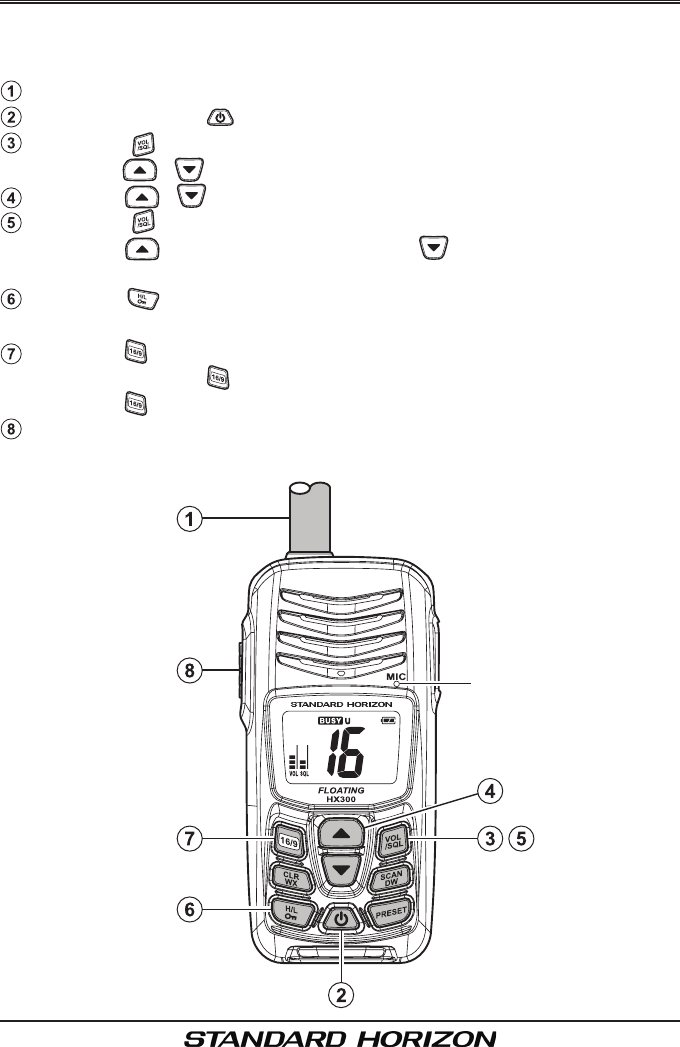
Page 3HX300
Quick RefeRence Guide
This transceiver is equipped with the E2O (Easy-To-Operate) system. You
can do the basic operation in numerical order of the illustration below.
Connect the supplied CAT460 antenna securely.
Press and hold the key to turn on or off the radio.
Press the key several times until the “VOL” indicator blinks, then
press the / key to adjust the speaker audio volume.
Press the / key to selects the operating channel.
Press the key several times until the “SQL” indicator blinks, then
press the key to squelch or press the key to un-squelch the ra-
dio.
Press the key to toggle the transmit power between High (5W) and
Low (1W).
Press the key briey to recall channel 16.
Press and hold the key for two seconds to recall channel 9.
Press the key again to revert to the last selected channel.
Place your mouth about 1 inch (2.5 cm) away from MIC hole and speak
in a normal voice level while pressing the PTT switch.
MIC Hole
FCC ID: K6630493X20 / IC: 511B-303493X20
Vertex Standard Co.,Ltd.
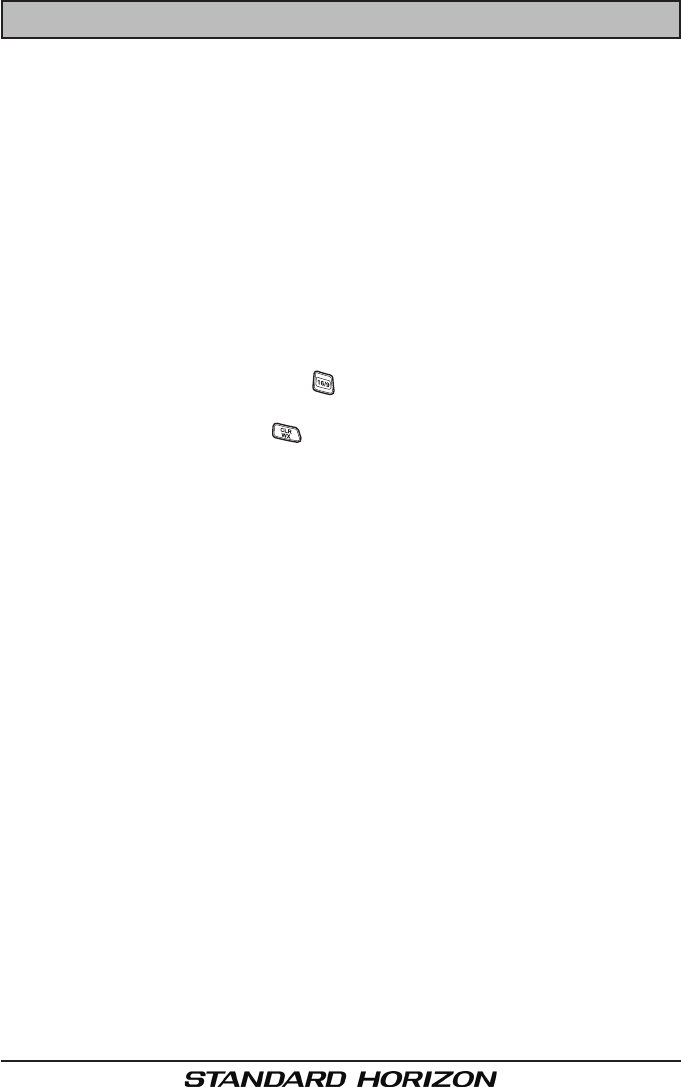
HX300Page 4
1. GENERAL INFORMATION
1.1 INTRODUCTION
Congratulations on your purchase of the HX300! Whether this is your rst
portable marine VHF transceiver, or if you have other STANDARD HORIZON
equipment, the STANDARD HORIZON organization is committed to ensuring
your enjoyment of this high performance transceiver, which should provide
you with many years of satisfying communications even in the harshest of
environments. STANDARD HORIZON technical support personnel stands
behind every product sold, and we invite you to contact us should you re-
quire technical advice or assistance.
The HX300 is a Submersible Floating 5-Watt portable two way marine trans-
ceiver. The transceiver has all allocated USA, International, or Canadian
channels. It has emergency channel 16 which can be immediately selected
from any channel by pressing the key. NOAA (National Oceanic and At-
mospheric Administration) Weather channels can also be accessed immedi-
ately by press and holding the key.
The HX300 includes the following features: Memory Scanning, Priority Scan-
ning, NOAA Weather Alert, easy-to-read large LCD display, EEPROM mem-
ory back-up, Battery Life displayed on LCD, the Water Hazard Lamp which
blinks automatically when fell in water, and a transmit Time-Out Timer (TOT).
The HX300 transmitter provides a full 5 Watt of transmit power and also is
selectable to 1 Watt to assist the user in ensuring maximum battery life.
We appreciate your purchase of the HX300, and encourage you to read this
manual thoroughly, so as to learn and fully understand the capabilities of the
HX300.
FCC ID: K6630493X20 / IC: 511B-303493X20
Vertex Standard Co.,Ltd.

Page 5HX300
1.2 SAFETY INFORMATION
Your wireless handheld portable transceiver contains a low power transmit-
ter. When the Push-to-Talk (PTT) button is pushed, the transceiver sends out
radio frequency (RF) signals. In August 1996, the Federal Communications
Commission adopted RF exposure guidelines with safety levels for hand-
held wireless devices.
This device is authorized to operate at a duty factor not to exceed 50% (this
corresponds to 50% transmission time and 50% reception time).
WARNING: To maintain compliance with the FCC’s RF exposure guidelines,
this transmitter and its antenna must maintain a separation distance of at
least 1 inch (2.5 centimeters) from your face. Speak in a normal voice, with
the antenna pointed up and away from the face at the required separation
distance.
Use only the supplied antenna. Unauthorized antennas, modications, or at-
tachments could damage the transmitter, and may violate FCC regulations.
FCC ID: K6630493X20 / IC: 511B-303493X20
Vertex Standard Co.,Ltd.
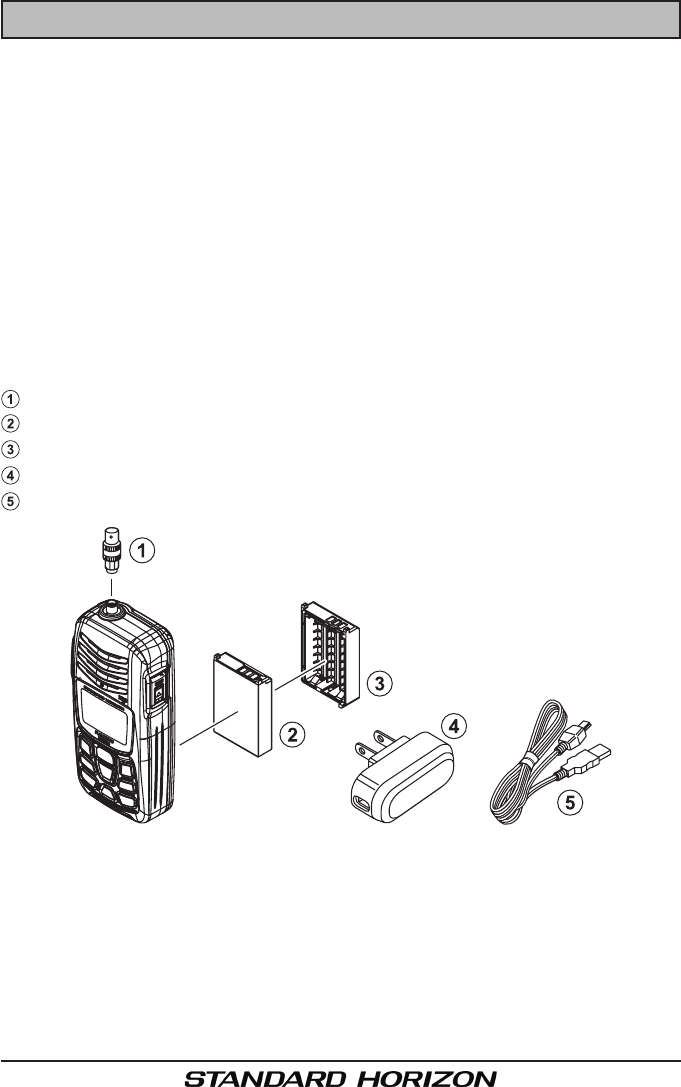
HX300Page 6
2. ACCESSORIES
2.1 PACKING LIST
When the package containing the transceiver is rst opened, please check it
for the following contents:
HX300 Transceiver
CAT460 Antenna
FNB-122LI 3.7 V, 1560 mAh Li-Ion Battery Pack
PA-54B 120VAC USB Wall Charger
Charge Cable (HX300 1 PA-54B)
CLIP-22 Belt Clip
Hand Strap
Owner’s Manual
2.2 OPTIONS
CN-3 Radio-to-Ship’s-Antenna Adapter
FNB-112LI 7.4 V, 1650 mAh Li-Ion Battery Pack
FBA-44 Alkaline Battery Case (3 x “AAA” Cell Size)
PA-54B/C/U USB Wall Charger
Charge Cable Connects HX300 and PA-54
: “B” sufx is for use with 120 VAC (Type-A plug), “C” sufx is for use with
230 VAC (Type-C plug), and “U” sufx is for use with 230 VAC (Type-BF
plug).
Note: Before operating the HX300 for the rst time, it is recommended that
the battery be charged. Please see section “4.2.3 BATTERY CHARGING”
for details.
FCC ID: K6630493X20 / IC: 511B-303493X20
Vertex Standard Co.,Ltd.

Page 7HX300
3. ABOUT THIS RADIO
3.1 ABOUT THE VHF MARINE BAND
The radio frequencies used in the VHF marine band lie between 156 and 158
MHz with NOAA Weather stations available between 161 and 163 MHz. The
marine VHF band provides communications over distances that are essen-
tially “Line of sight” Actual transmission range depends much more on an-
tenna type, gain and height than on the power output of the transmitter. On a
xed mount 25 W radio transmission expected distances can be greater than
15 miles, for a portable 5 W radio transmission the expected distance can be
greater than 5 miles in “Line of sight”.
The user of a Marine VHF radio is subject to severe nes if the radio is used
on land. The reasoning for this is you may be near an inland waterway, or
propagation anomalies may cause your transmission to be heard in a water-
way. If this occurs, depending upon the marine VHF channel on which you
are transmitting, you could interfere with a search and rescue case, or con-
tribute to a collision between passing ships. For VHF Marine channel assign-
ments refer to section “9 VHF MARINE CHANNEL CHART ASSIGNMENT”.
WARNING
This radio is capable of transmitting on Marine VHF.
The FCC allows the use of VHF Marine band on water areas only.
However the FCC does not allow the use of the VHF Marine band
when on land. If persons use the VHF Marine Band on land and inter-
fere with others communicating, the FCC will be notied and search
for the interference. Responsible parties found to be transmitting on
the VHF Marine Band on land could be ned up to $10,000 for the
rst offense.
3.2 ABOUT WATER RESISTANCE
Water resistance of the transceiver is ensured only when the Battery Cover
and CHG Cover is attached to the transceiver certainty.
3.3 DISTRESS AND HAILING (CHANNEL 16)
Channel 16 is known as the Hail and Distress Channel. An emergency may
be dened as a threat to life or property. In such instances, be sure the trans-
ceiver is on and set to “Channel 16”. Then use the following procedure:
1. Press the PTT (Push-To-Talk) switch and say “Mayday, Mayday, May-
day. This is _____, _____, _____” (your vessel’s name).
2. Then repeat once: “Mayday, _____” (your vessel’s name).
FCC ID: K6630493X20 / IC: 511B-303493X20
Vertex Standard Co.,Ltd.

HX300Page 8
3. Now report your position in latitude/longitude, or by giving a true or mag-
netic bearing (state which) to a well-known landmark such as a naviga-
tion aid or geographic feature such as an island or harbor entry.
4. Explain the nature of your distress (sinking, collision, aground, re, heart
attack, life-threatening injury, etc.).
5. State the kind of assistance your desire (pumps, medical aid, etc.).
6. Report the number of persons aboard and condition of any injured.
7. Estimate the present seaworthiness and condition of your vessel.
8. Give your vessel’s description: length, design (power or sail), color and
other distinguishing marks. The total transmission should not exceed 1
minute.
9. End the message by saying “OVER”. Release the PTT switch and listen.
10. If there is no answer, repeat the above procedure. If there is still no re-
sponse, try another channel.
3.4 CALLING ANOTHER VESSEL (CHANNEL 16 OR 9)
Channel 16 may be used for initial contact (hailing) with another vessel.
However, its most important use is for emergency messages. This channel
must be monitored at all times except when actually using another channel.
It is monitored by the U.S. and Canadian Coast Guards and by other ves-
sels. Use of channel 16 for hailing must be limited to initial contact only. Call-
ing should not exceed 30 seconds, but may be repeated 3 times at 2-minute
intervals. In areas of heavy radio trafc, congestion on channel 16 resulting
from its use as a hailing channel can be reduced signicantly in U.S. waters
by using Channel 9 as the initial contact (hailing) channel for non-emergency
communications. Here, also, calling time should not exceed 30 seconds but
may be repeated 3 times at 2-minute intervals.
Prior to making contact with another vessel, refer to the channel charts in this
manual, and select an appropriate channel for communications after initial
contact. For example, Channels 68 and 69 of the U.S. VHF Charts are some
of the channels available to non-commercial (recreational) boaters. Monitor
your desired channel in advance to make sure you will not be interrupting
other trafc, and then go back to either channel 16 or 9 for your initial contact.
When the hailing channel (16 or 9) is clear, state the name of the other ves-
sel you wish to call and then “this is” followed by the name of your vessel
and your Station License (Call Sign). When the other vessel returns your
call, immediately request another channel by saying “go to”, the number of
the other channel, and “over”. Then switch to the new channel. When the
new channel is not busy, call the other vessel.
FCC ID: K6630493X20 / IC: 511B-303493X20
Vertex Standard Co.,Ltd.

Page 9HX300
After a transmission, say “over”, and release the PTT (Push-To-Talk) switch.
When all communication with the other vessel is completed, end the last
transmission by stating your Call Sign and the word “out”. Note that it is not
necessary to state your Call Sign with each transmission, only at the begin-
ning and end of the contact.
Remember to return to Channel 16 when not using another channel. Some
radios automatically monitor Channel 16 even when set to other channels or
when scanning.
3.5 OPERATING ON CHANNEL 13
Channel 13 is used at docks, bridges and for maneuvering in port. Messages
on this channel must concern navigation only, such as meeting and pass-
ing in restricted waters. In emergencies and when approaching blind river
bends, High power is allowed. Pressing the key will change the power
output from Low Power (1 Watt) to High (5 Watts). When you change from
this channel then return to it, low power will be automatically selected.
3.6 OPERATING ON CHANNEL 67
When channel 67 is used for navigational bridge-to-bridge trafc between
ships, Normal, High or Medium power may be used temporarily (in the USA
band) by pressing the key. When you select this channel again, the
transceiver will revert to low power.
3.7 SIMPLEX/DUPLEX CHANNEL USE
Refer to the section “9 VHF MARINE CHANNEL CHART ASSIGNMENT” for
instructions on use of simplex and duplex channels.
NOTE
All channels are factory-programmed in accordance with FCC (USA),
Industry Canada and International regulations. The mode of opera-
tion cannot be altered from simplex to duplex or vice-versa. Simplex
(ship to ship) or duplex (marine operator) mode is automatically acti-
vated, depending on the channel and whether the USA, International
or Canadian operating band is selected.
FCC ID: K6630493X20 / IC: 511B-303493X20
Vertex Standard Co.,Ltd.
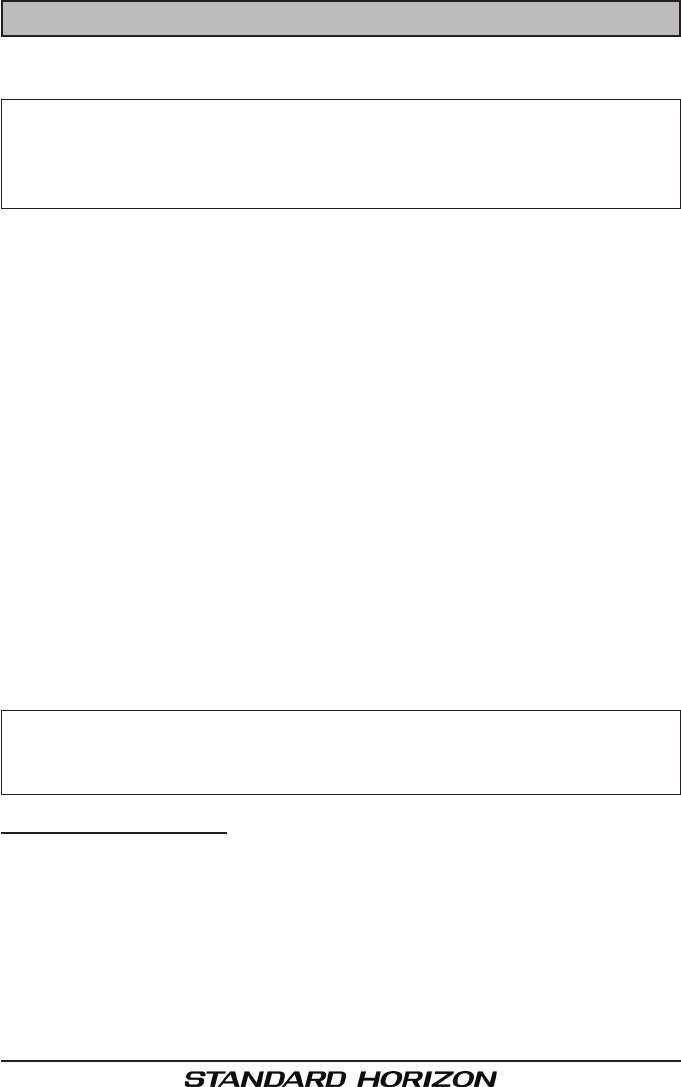
HX300Page 10
4. GETTING STARTED
4.1 RADIO CARE
CAUTION
Before following the instructions below, insure the battery pack is
in place and rmly tightened. Care must be taken if the radio was
dropped and a close inspection may be needed to insure the radio
case and gaskets are in adequate condition.
After using the HX300 in salt water environment is recommended to clean
the radio with fresh water after exposure to salt water by rinsing the radio
under a sink faucet or by dunking the radio in a bucket of fresh water. After
washing, use a soft cloth and thoroughly dry all parts of the radio. This is to
keep the rubber switches and speaker grill clean and in top operating condi-
tion.
4.2 BATTERIES AND CHARGERS
If the radio has never been used, or its charge is depleted, it may be charged
by connecting the PA-54B USB Wall Charger with the Charge Cable, see
section “4.3.3 BATTERY CHARGING”. The PA-54B will charge a completely
discharged FNB-112LI battery pack in about 6 hours.
If the USB port is available (such as your personal computer), You may
charge the FNB-112LI battery pack by connecting the supplied Charge Ca-
ble between the HX300 and USB port.
The FNB-112LI is a high performance Li-Ion battery providing high capacity
in a compact package.
CAUTION
To avoid risk of explosion and injury, FNB-112LI battery pack should
only be removed, charged or recharged in non-hazardous environ-
ments.
4.2.1 BATTERY SAFETY
Battery packs for your transceiver contain Li-Ion batteries. This type of bat-
tery stores a charge powerful enough to be dangerous if misused or abused,
especially when removed from the transceiver. Please observe the following
precautions:
DO NOT SHORT BATTERY PACK TERMINALS: Shorting the terminals
that power the transceiver can cause sparks, severe overheating, burns, and
battery cell damage. If the short is of sufcient duration, it is possible to melt
battery components. Do not place a loose battery pack on or near metal sur-
FCC ID: K6630493X20 / IC: 511B-303493X20
Vertex Standard Co.,Ltd.

Page 11HX300
faces or objects such as paper clips, keys, tools, etc. When the battery pack
is installed on the transceiver, the terminals that transfer current to the trans-
ceiver are not exposed. The terminals that are exposed on the battery pack
when it is mounted on the transceiver are charging terminals only and do not
constitute a hazard.
DO NOT INCINERATE: Do not dispose of any battery in a re or incinerator.
The heat of re may cause battery cells to explode and/or release dangerous
gases.
Battery Maintenance
For safe and proper battery use, please observe the following:
Battery packs should be charged only in non-hazardous environ-
ments;
Use only STANDARD HORIZON-approved batteries;
Use only a STANDARD HORIZON approved charger. The use of any
other charger may cause permanent damage to the battery.
Follow charging instructions provided with the chargers.
Keep the battery contacts clean.
Battery Storage
Store the batteries in a cool place to maximize storage life. Since batteries
are subject to self-discharge, avoid high storage temperatures that cause
large self-discharge rates. After extended storage, a full recharge is recom-
mended.
Battery Recycling
DO NOT PLACE USED BATTERIES IN YOUR REGULAR TRASH!
LI-ION BATTERIES MUST BE COLLECTED, RECYCLED OR DISPOSED
OF IN AN ENVIRONMENTALLY SOUND MANNER.
The incineration, land lling or mixing of Li-Ion batteries with the municipal
solid waste stream is PROHIBITED BY LAW in most areas.
Return batteries to an approved Li-Ion battery recycler. This may be where
you purchased the battery.
Contact your local waste management ofcials for other information regard-
ing the environmentally sound collection, recycling and disposal of Li-Ion bat-
teries.
FCC ID: K6630493X20 / IC: 511B-303493X20
Vertex Standard Co.,Ltd.
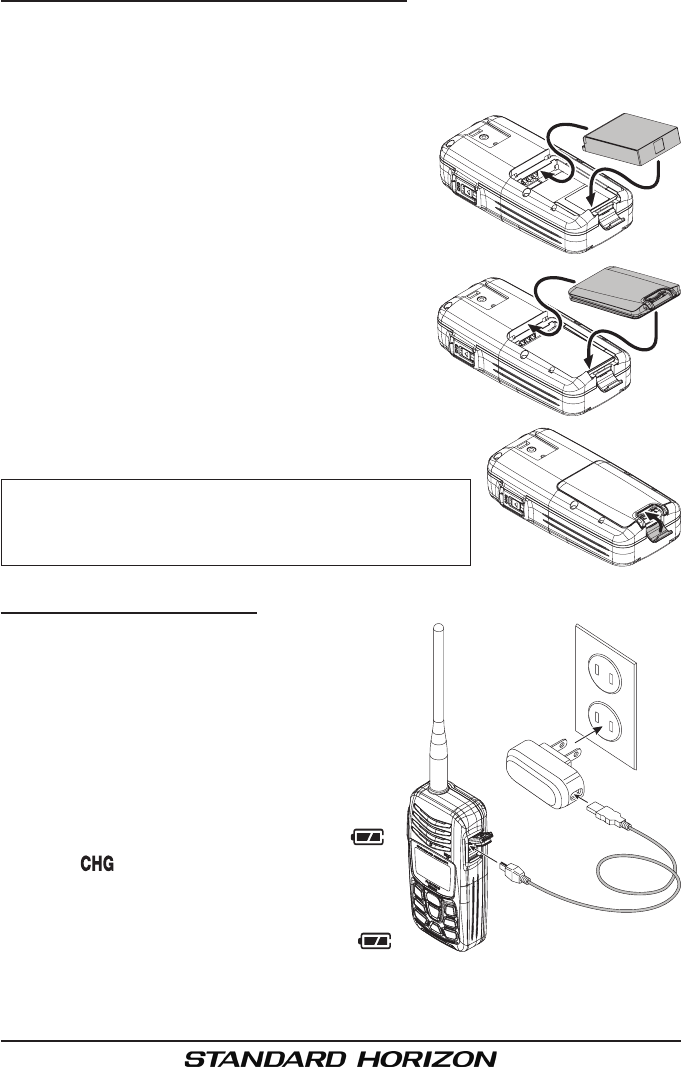
HX300Page 12
4.2.2 BATTERY INSTALLATION / REMOVAL
Open the Battery Pack Latch on the bottom of the radio, then remove the
Battery Cover from the radio while pulling the bottom side of the Battery
Cover.
Install the FNB-122LI Battery Pack into the Battery Nest of the radio,
carefully mate the battery’s two alignment
tabs on the top side of the Battery Pack with
their corresponding alignment slots in the
Battery Nest of the radio, then gently press
the bottom side of the Battery Pack until it
locks in place.
Replace the Battery Cover to the radio,
carefully mate the two alignment tabs on the
Batter Cover with their corresponding align-
ment slots on the radio, then gently press
the bottom side of the Battery Cover.
Close the Battery Pack Latch until it locks in
place with a “Click”.
CAUTION
The HX300 does NOT keep the water resis-
tance when the Battery Cover is not closed
securely.
4.2.3 BATTERY CHARGING
1. Turn the transceiver off.
2. Slide the CHG cover knob to open the
CHG cover, then connect the supplied
Charge Cable to the CHG jack on the
HX300.
3. Connect the other side plug of the sup-
plied Charge Cable to the PA-54B, then
plug the PA-54B into the AC line outlet.
4. If the connection is correct, the “ ”
and “ ” icon will appear in the display.
A fully-discharged pack will be charged
completely in approximately 6 hours.
5. When charging is completed, the “
” icon disappears and “FL” notation will appear in the display. Disconnect
the Charge Cable from the HX300 and close the CHG cover securely,
then unplug the PA-54B from the AC line outlet.
FCC ID: K6630493X20 / IC: 511B-303493X20
Vertex Standard Co.,Ltd.
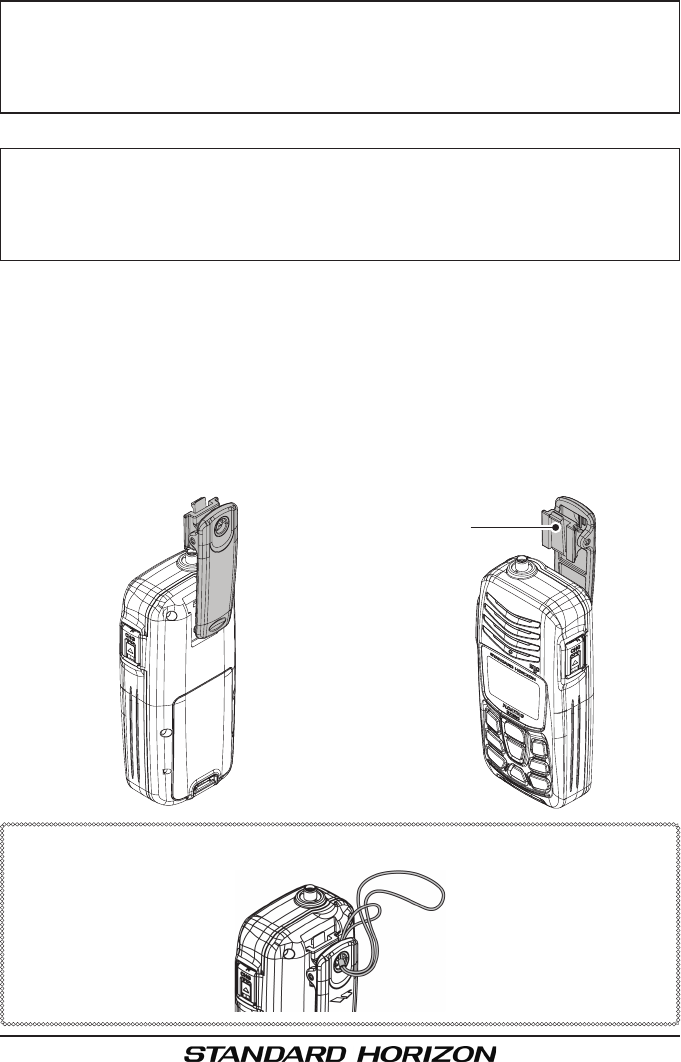
Page 13HX300
CAUTION
The HX300 does NOT keep the water resistance when the CHG
Cover is not closed securely.
The PA-54B is NOT designed to be waterproof. Do not attempt to
charge in water hazardous locations.
NOTE
The PA-54B is only designed for the charging of the HX300’s battery
pack, and is not suitable for other purposes. The PA-54B may con-
tribute noise to TV and radio reception in the immediate vicinity, so
we do not recommend its use adjacent to such device.
4.3 BELT CLIP INSTALLATION / REMOVAL
To install the Belt Clip: align the
Belt Clip to the groove of the
Battery pack, then press the Belt
Clip downward until it locks in
place with a “Click”.
To remove the Belt Clip: press
the Belt Clip Tab away from the
battery pack to unlock the Belt
Clip, then slide the Belt Clip up-
ward to remove it.
é
ê
Belt Clip Tab
NAND STRAP INSTALLATION
FCC ID: K6630493X20 / IC: 511B-303493X20
Vertex Standard Co.,Ltd.
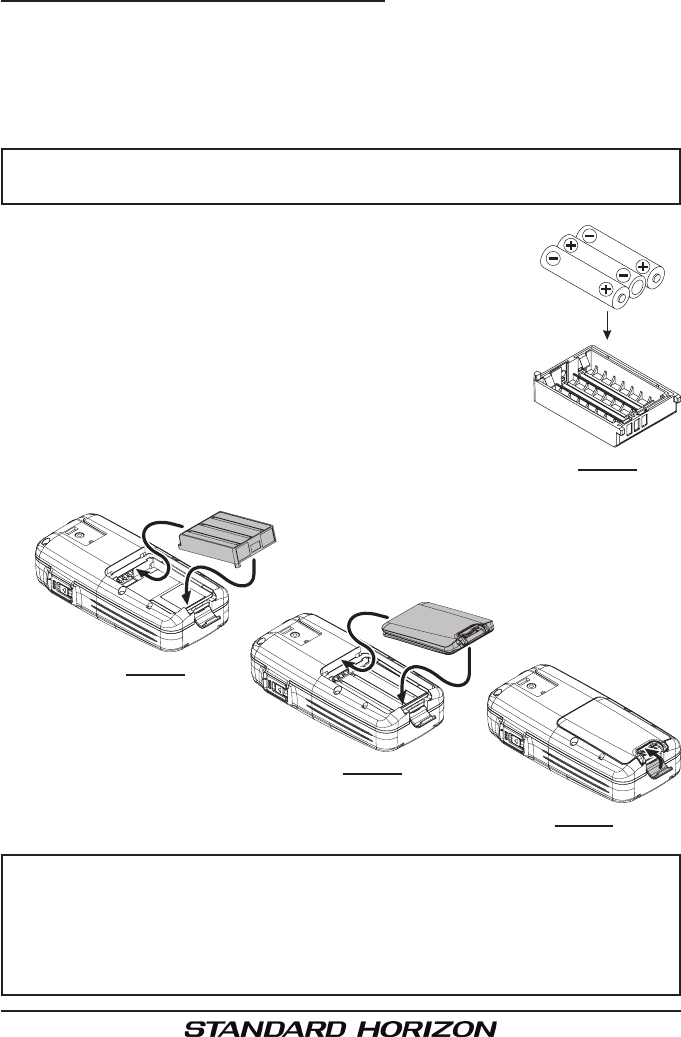
HX300Page 14
4.4 INSTALLATION OF OPTION
4.4.1 FBA-44 ALKALINE BATTERY CASE
FBA-44 is a Battery Case that holds three “AAA” size Alkaline Batteries and
is used with the HX300 transceiver. When the FBA-44 is installed into the
HX300, the radio can withstand immersion in water up to 3.3 ft (1 m) for 30
minutes.
IMPORTANT NOTE
The power output will be reduced to “Low Power” (1 W) automatically
when using the FBA-44.
Install the three “AAA” size Alkaline Batteries into the
FBA-44 Battery Case with the Negative (–) side of the
batteries touching the spring connections inside the
FBA-44 Battery Case (Figure 1).
Turn over the FBA-44 Battery Case, then insert the
FBA-44 Battery Case into the Battery Compartment,
by a same manner of the installation of the FNB-122LI
(Figure 2).
Replace the Battery Cover to the radio (Figure 3), then
close the Battery Pack Latch until it locks in place with
a “Click” (Figure 4).
NOTE
The FBA-44 is designed for use only with “AAA” size Alkaline
Cells. Do not attempt to install any rechargeable battery cell.
If you do not use the HX300 for a long time, remove the Alkaline
batteries from the FBA-44, as battery leakage could cause dam-
age to the FBA-44 and/or HX300.
Figure 1
Figure 2
Figure 3
Figure 4
FCC ID: K6630493X20 / IC: 511B-303493X20
Vertex Standard Co.,Ltd.
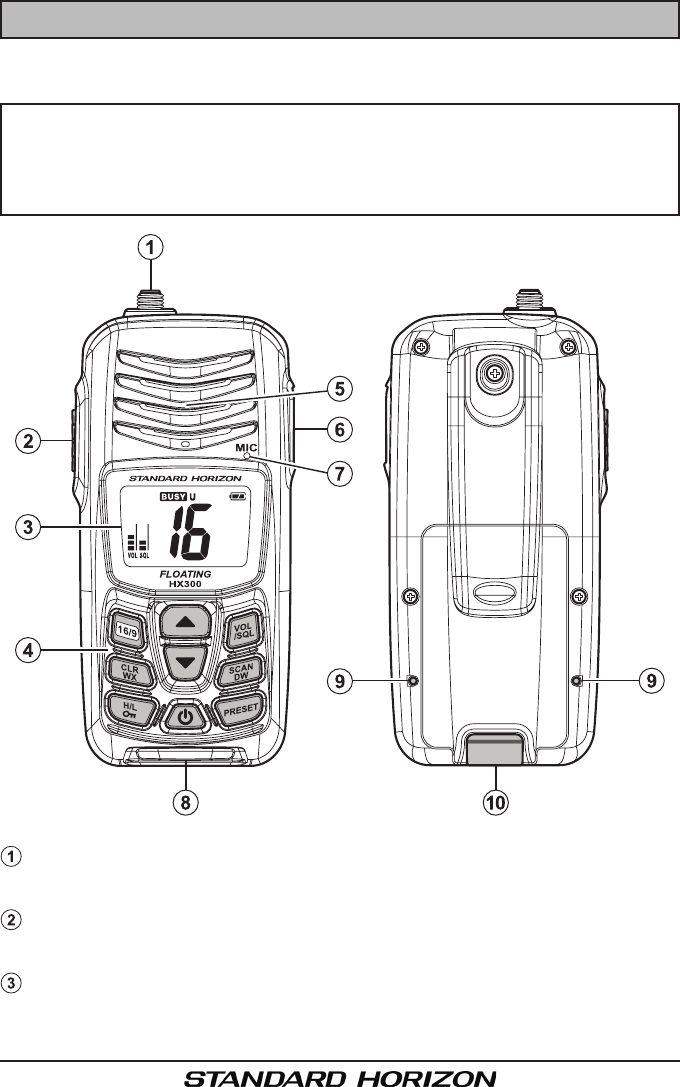
Page 15HX300
5. CONTROLS AND INDICATORS
5.1 CONTROLS AND SWITCHES
NOTE
This section denes each control of the transceiver. For detailed oper-
ating instructions, refer to section “6 BASIC OPERATION”. Refer to
illustrations for the location of the following controls, switches, and
connections.
ANT Jack (Top Panel)
The supplied CAT460 exible antenna is attached here.
PTT (PUSH-TO-TALK) Switch (Left Side Panel)
When pushed activates the transmitter.
LCD Display
This display shows current operating conditions, as indicated on the
page 18.
FCC ID: K6630493X20 / IC: 511B-303493X20
Vertex Standard Co.,Ltd.
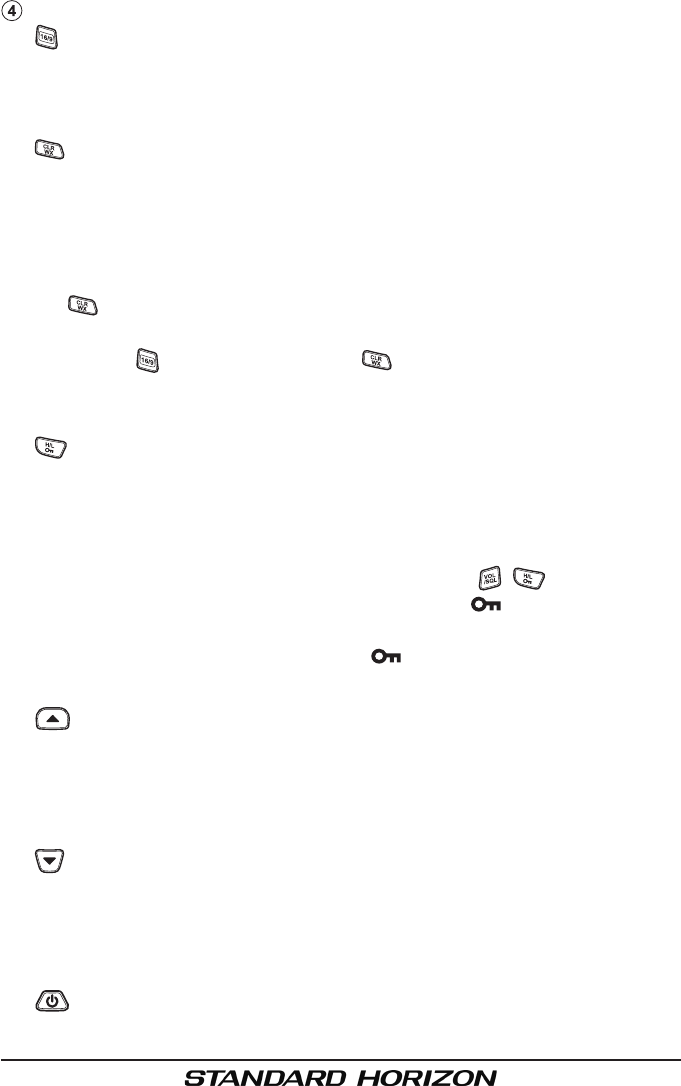
HX300Page 16
Keypad
Key
Pressing this key immediately recalls channel 16 from any channel loca-
tion. Holding down this key recalls channel 9. Pressing this key again
reverts to the previous selected working channel.
Key
Press to stop the Scan, Priority Scan, or Dual Watch feature.
Secondary use:
Press and hold this key immediately recall the last-used NOAA (National
Oceanic and Atmospheric Administration) Weather Channel from any
channel location. Recalls the previously- selected working channel when
the key is pressed again.
Advanced use:
When the key is held and the key is pressed, the radio will
change the marine band between the USA, International, and Canadian
channels.
Key
Press this key to toggle the transmitter output power between “High”
(5 Watts) and “Low” (1 Watt) power. This key does not function on the
“Transmission Inhibited” and “Low power only” channels.
Secondary use:
Hold down this key to lock the keypad (except the , and PTT keys)
so that they are not accidentally changed. The “ ” icon will appear at
the bottom right corner on the display, to indicate that the functions are
locked. Hold down this key until the “ ” icon disappears to unlock the
radio.
Key
Press this key used to change the operating channel, receiver volume
level, and squelch threshold level.
Press the key momentarily, the channel (or level) increase one step.
Holding the key, channel (or level) increase continuously.
Key
Press this key used to change the operating channel, receiver volume
level, and squelch threshold level.
Press the key momentarily, the channel (or level) decrease one step.
Holding the key, channel (or level) decrease continuously.
Key
Press and hold this key for two seconds to turn the radio “on” or “off”.
FCC ID: K6630493X20 / IC: 511B-303493X20
Vertex Standard Co.,Ltd.
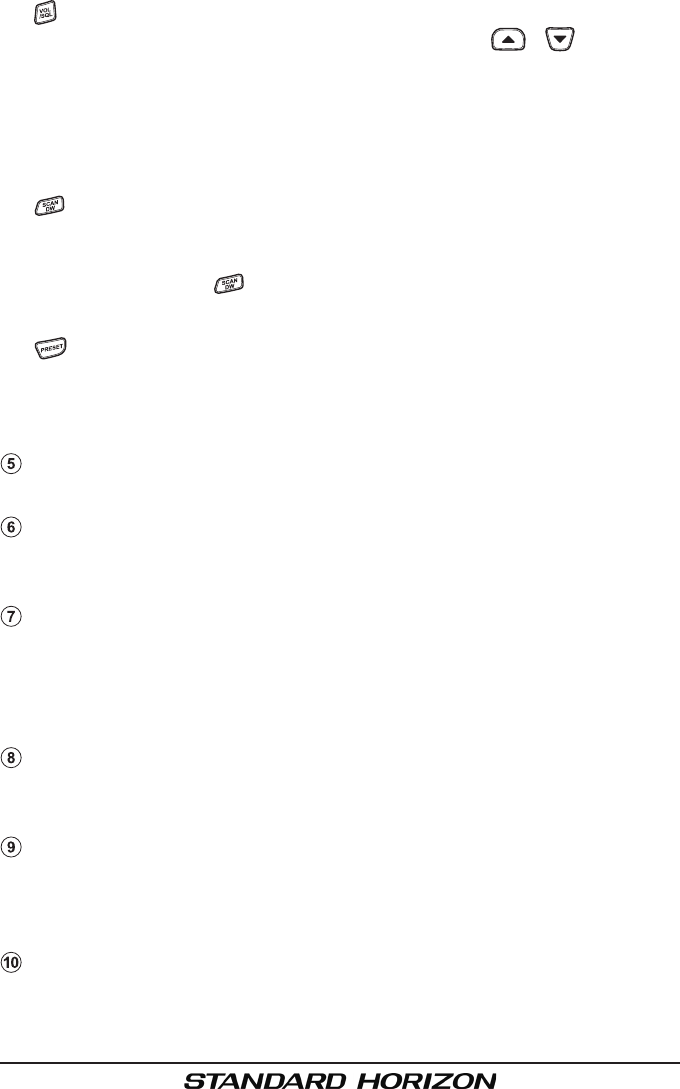
Page 17HX300
Key
Press this key to toggle the operation mode of the / key among
the VOL adjustment, SQL adjustment, and Channel selection.
Secondary use:
Press and holding this key to open the squelch, allowing you to monitor
the operating channel. Release the key to resume normal (quiet) moni-
toring.
Key
Starts scanning and priority scanning of programmed channels.
Secondary use:
Press and hold the key for two seconds to activate the Dual Watch
feature.
Key
Immediately recalls one of up to 10 user preset memories for each band
(shown as “0” - “9” on the LCD). Pressing this key repeatedly scrolls
through the preset memory channels.
Speaker
The internal speaker is located here.
CHG Jack (Left Side Panel)
This mini-USB (Type-B) jack allows to connection to the supplied PA-54B
USB Wall Charger with the supplied Charge Cable.
Microphone
The internal microphone is located here.
When transmitting, position your mouth about 1/2 to 1 inch (1.2 ~ 2.5 cm)
away from the small mic hole. Speak slowly and clearly into the micro-
phone.
Water Hazard Lamp
When the HX300 fell in water, this lamp blinks in red to inform a emer-
gency.
Water Hazard Terminal
These terminals are detection terminal for the Water Hazard Lamp.
When these terminals touch to the water, the Water Hazard Lamp blinks
in red to inform a emergency. Keep these terminals clean.
Battery Pack Latch (Bottom side)
Open the battery pack lock latch to for battery case cover removal.
FCC ID: K6630493X20 / IC: 511B-303493X20
Vertex Standard Co.,Ltd.
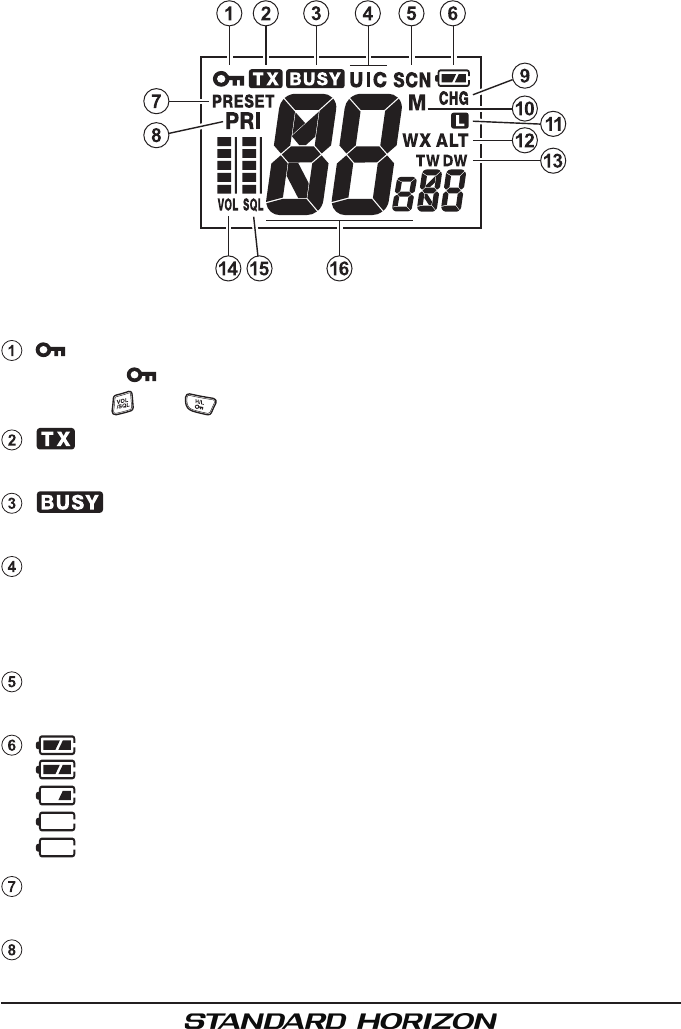
HX300Page 18
5.2 LCD INDICATORS
“ ” Indicator
When the “ ” icon is shown on the LCD, all keys are disabled except for
the PTT, , and keys.
“ ” Indicator
This indicator appears during transmission.
“ ” Indicator
This indicator appears when a signal is being received.
“U/I/C” Indicator
These indicators show the “band” of operation for the particular channel.
“U” indicates the USA band; “I” indicates the International band; and “C”
indicates the Canadian band.
“SCN” Indicator
This indicator appears when the Scan is activated.
“ ” Battery Indicator
“ ”: Full battery
“ ”: Lower battery
“ ”: Battery is very low
“ (Blinking)”: Prepare to charge the battery
“PRESET” Indicator
This indicator shows the channel is in the “Preset Channel”.
“PRI” Indicator
This indicator shows the channel is in the “Priority Channel”.
FCC ID: K6630493X20 / IC: 511B-303493X20
Vertex Standard Co.,Ltd.
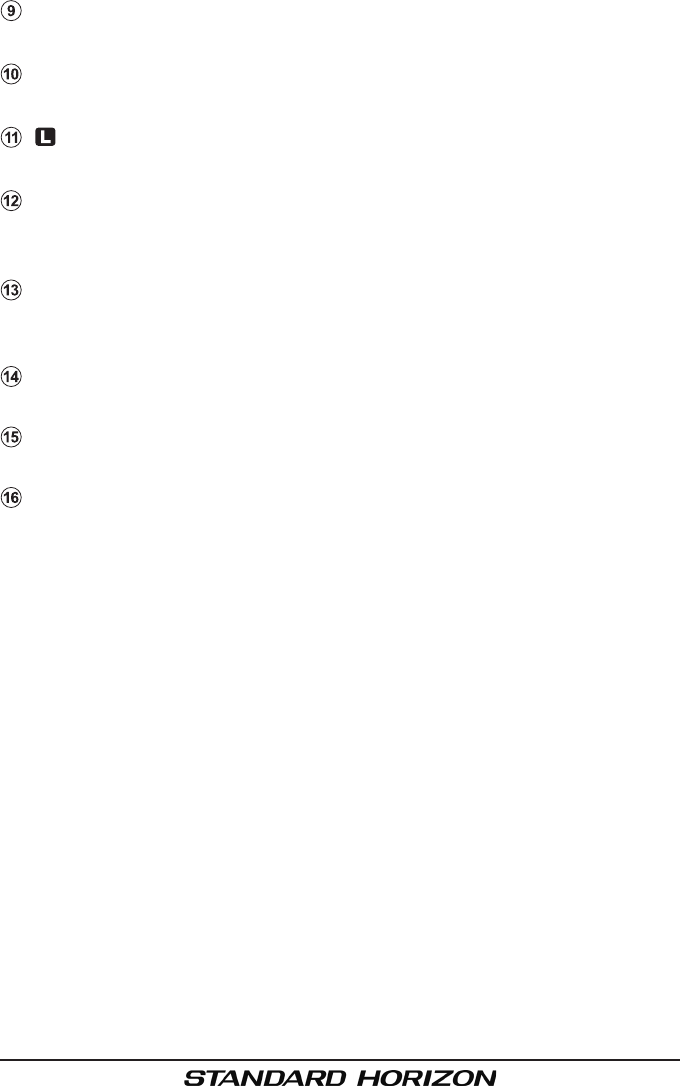
Page 19HX300
“CHG” Indicator
This indicator appears during battery charging.
“M” Indicator
This indicator shows the channel is in the transceiver’s “Scan Memory”.
“ ” Indicators
This indicator shows the TX output power is “Low” (1 Watt) power.
“WX ALT” Indicator
“WX”: NOAA weather channel is selected.
“WX ALT”: “Weather Alert” is received.
“TW DW” Indicator
“TW”: Triple Watch is activated.
“DW”: Dual Watch is activated.
VOL Indicator
This indicator shows the receiver audio volume level.
SQL Indicator
This indicator shows the squelch level.
Channel Display
The operating channel is shown on the LCD in both the transmission and
reception modes.
FCC ID: K6630493X20 / IC: 511B-303493X20
Vertex Standard Co.,Ltd.
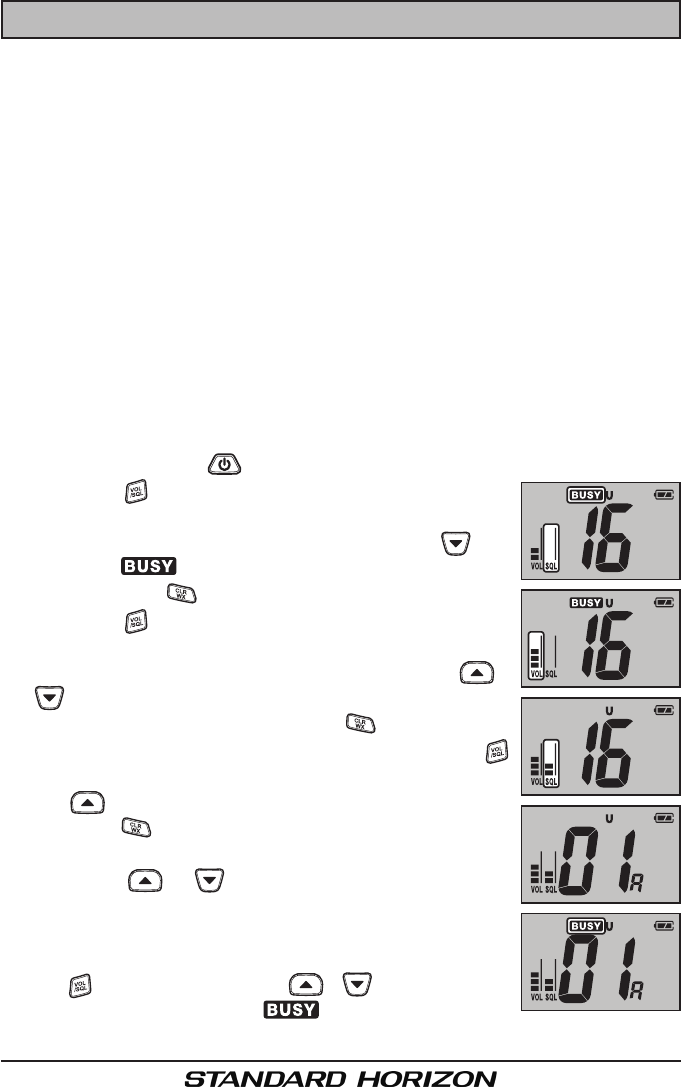
HX300Page 20
6. BASIC OPERATION
6.1 PROHIBITED COMMUNICATIONS
The FCC prohibits the following communications:
False distress or emergency messages:
Messages to “any boat” except in emergencies and radio tests;
Messages to or from a vessel on land;
Transmission while on land;
Obscene, indecent, or profane language (potential ne of $10,000).
6.2 INITIAL SETUP
1. Install the battery pack on the transceiver (see section “4.2.2 BATTERY
INSTALLATION/REMOVAL”).
2. Install the antenna onto the transceiver; hold the bottom end of the an-
tenna, then screw it onto the mating connector on the transceiver until it
is snug. Do not over-tighten.
6.3 RECEPTION
1. Press and hold the key for two seconds to turn the radio “on”.
2. Press the key several times until the “SQL” indica-
tor blinks (activate the squelch adjusting mode).
3. While blinking the “SQL” indicator, press the key
until the “ ” indicator will appear on the display,
then press the key.
4. Press the key several times until the “VOL” indica-
tor blinks (activate the audio volume adjusting mode).
5. While blinking the “VOL” indicator, press the /
key until the noise or audio from the speaker is at
a comfortable level, then press the key.
6. Activate the squelch adjusting mode by press the
key several times (the “SQL” indicator blinks). Press
the key until the random noise disappears, then
press the key. This state is known as the “Squelch
Threshold”.
5. Press the or key to select the desired chan-
nel. Refer to section “9. VHF MARINE CHANNEL
ASSIGNMENTS” for available channels.
6. When a signal is received, adjust the volume (press
the key, followed by the / key) to the de-
sired listening level. The “ ” indicator in the LCD
is displayed indicating that the channel is being used.
FCC ID: K6630493X20 / IC: 511B-303493X20
Vertex Standard Co.,Ltd.
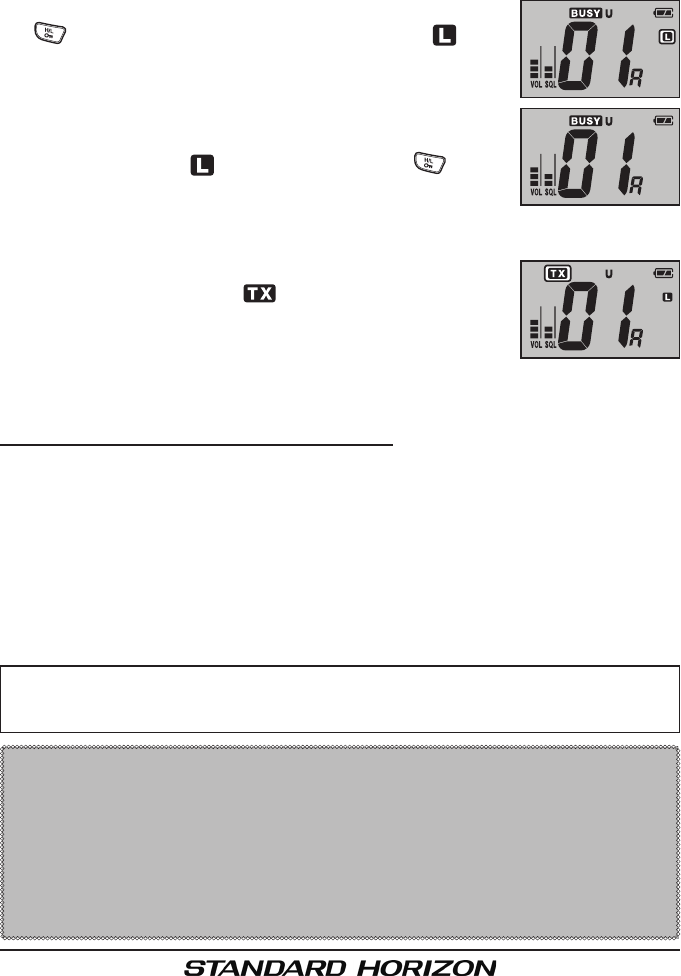
Page 21HX300
6.4 TRANSMISSION
1. Perform “6.3 RECEPTION” discussion above.
2. Before transmitting, monitor the channel and make sure it is clear.
THIS IS AN FCC REQUIREMENT!
3. For communications over short distances, press the
key to select the Low power (1 watt: “ ” icon
appears).
Note: Transmitting on Low power prolongs battery life.
Low power should be selected whenever possible.
4. If using Low power is not effective, select High power (5
watts: disappear “ ” icon) by pressing the key.
5. When receiving a signal, wait until the incoming sig-
nal stops before transmitting. The transceiver cannot
transmit and receive simultaneously.
6. Press the PTT (Push-To-Talk) switch to transmit. Dur-
ing transmission, the “ ” indicator will appear on
the display.
7. Position your mouth about 1/2 to 1 inch (1.2 ~ 2.5 cm)
away from the mic hole. Speak slowly and clearly into the microphone.
8. When the transmission is nished, release the PTT switch.
6.4.1 TRANSMIT TIME - OUT TIMER (TOT)
While the PTT switch is held down, transmission time is limited to 5 minutes.
This prevents prolonged (unintentional) transmissions. About 10 seconds
before automatic transmitter shutdown, a warning beep will sound from the
speaker. The transceiver automatically switches to the receiving mode, even
if the PTT switch is held down. Before transmitting again, the PTT switch
must rst be released, then wait 10 seconds and then pressed again. This
Time-Out-Timer (TOT) prevents a continuous transmission that would result
from an accidentally stuck PTT switch.
The PTT switch is ignored for 10 seconds after the transceiver auto-
matically switches to the receiving mode by the TOT feature.
WATER HAZARD LAMP
When the HX300 fell in water, the Water Hazard Lamp will blink. The
Water Hazard Lamp will turn off automatically approximately 15 sec-
onds later when pull up the HX300 from water.
You may select the operation mode of the Water Hazard Lamp (refer
to Menu Mode Item “FL (WATER HAZARD LAMP FUNCTION)” on
page 29).
FCC ID: K6630493X20 / IC: 511B-303493X20
Vertex Standard Co.,Ltd.
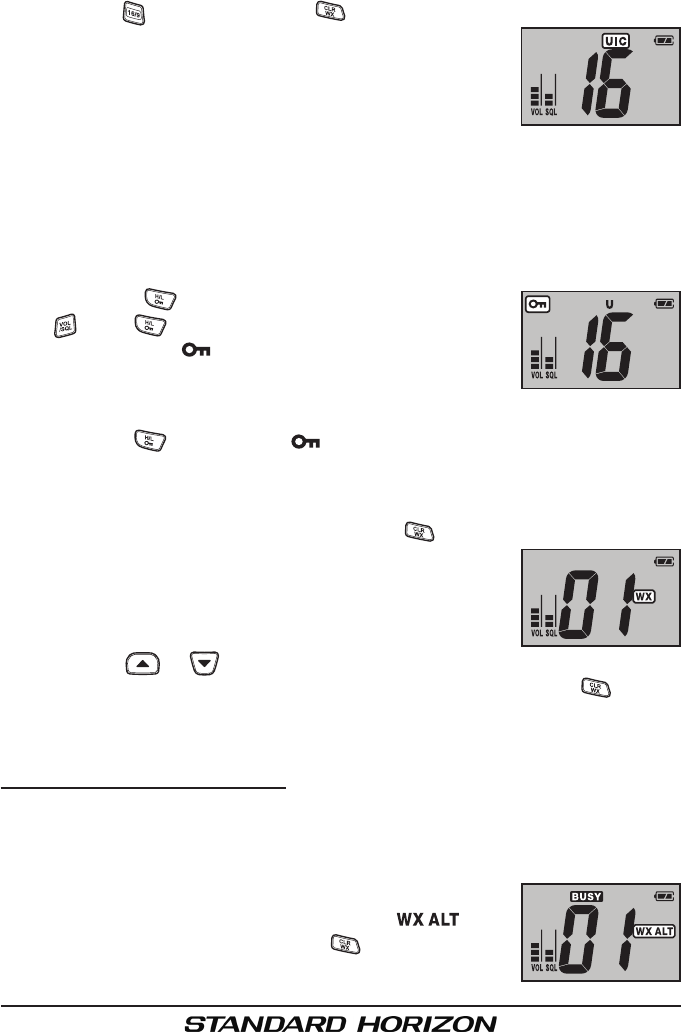
HX300Page 22
6.5 USA, CANADIAN, AND INTERNATIONAL CHANNELS
1. To change from US to International or Canadian Marine Channels, hold
down the key and press the key. The band will change from USA,
to International, and to Canadian with each press.
2. “U” appears on the LCD for the USA band, “I” ap-
pears for the International band, and “C” appears for
the Canadian band
3. Refer to the marine channel charts in section “9. VHF MARINE CHAN-
NEL ASSIGNMENTS” for allocated channels.
6.6 KEYPAD LOCKING
In order to prevent accidental channel change, the HX300’s keypad may be
locked out.
Hold down the key to lock the keypad (except the
PTT, , and keys) so that they are not acciden-
tally changed. The “ ” icon will appear on the channel
number of the display, to indicate that the functions are
locked.
Hold down the key until the “ ” icon disappears to unlock the radio.
6.7 NOAA WEATHER CHANNELS
1. To receive a NOAA (National Oceanic and Atmospheric Administration)
weather broadcast, press and hold the key for two seconds. The
transceiver changes to the weather channel mode
and the radio will be set to the last used NOAA weath-
er channel. This mode consists of a preset memory
bank containing the NOAA weather channels.
2. Press the or key to change to other weather channels.
3. To exit from the weather channel mode, press and hold the key for
two seconds. The transceiver will revert to the channel you were using
prior to switching to the weather channel mode.
6.7.1 NOAA WEATHER ALERT
In the event of extreme weather disturbances such as storms and hurri-
canes, NOAA sends a “Weather Alert” consisting of a 1050 Hz tone, followed
by weather reports on the weather channels.
When a “Weather Alert” is received on a weather chan-
nel, the transceiver emits a beep tone and “ ” icon
is shown on the display. Press the key to stop the
beep tone and listen to the weather reports.
FCC ID: K6630493X20 / IC: 511B-303493X20
Vertex Standard Co.,Ltd.
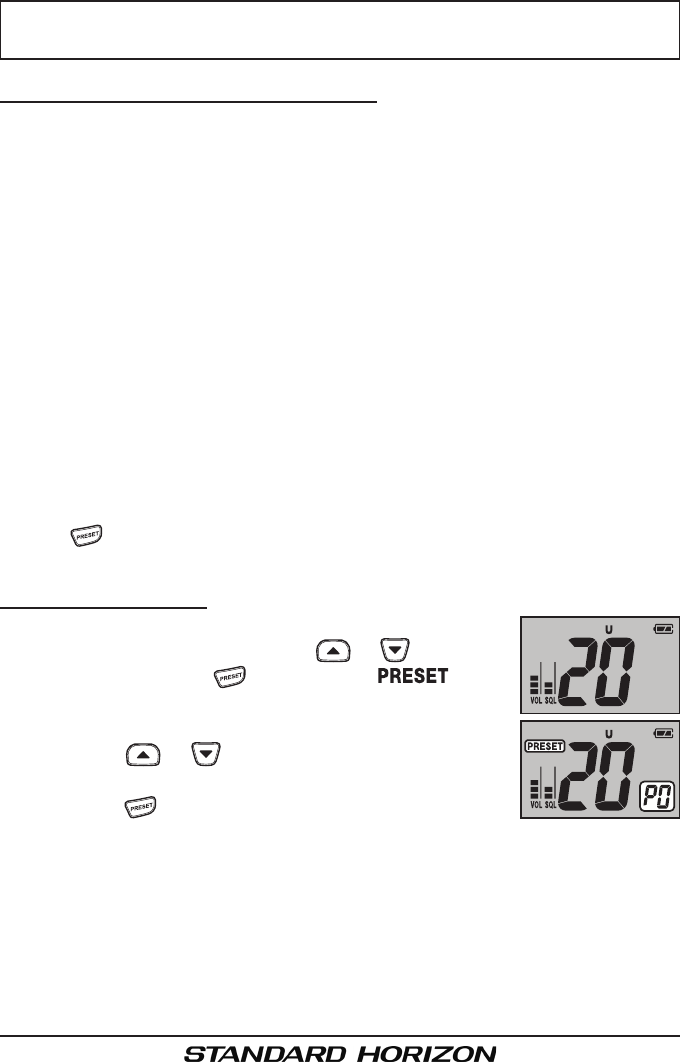
Page 23HX300
NOTE
Options for the Weather Alert feature are available, refer to Menu
Mode Item “AL (WX ALERT)” on page 29 for details.
6.7.2 NOAA WEATHER ALERT TESTING
In the event of a major storm or other appreciable weather condition requiring
vessels at sea (or other bodies of water) to be notied, the NOAA (National
Oceanographic and Atmospheric Administration) broadcasts a 1050 Hz tone
that some VHF radios, including your transceiver, can detect for “Weather
Alarm” purposes (refer to section “6.8.1 NOAA WEATHER ALERT” for a
discussion of how to use this feature). The 1050 Hz tone, when detected,
will produce a loud beep in the speaker of the transceiver, to signal that a
Weather Alert Broadcast is being received.
In order to test this system, NOAA broadcasts the 1050 Hz tone every
Wednesday sometime between 11 AM and 1 PM local time. You may use this
opportunity to test your transceiver periodically to conrm that the Weather
Alert feature is working, or for training crew members on how to congure
the transceiver to receive the NOAA Weather Alerts.
6.8 PRESET CHANNELS (0 ~ 9): INSTANT ACCESS
Ten user assigned channels can be programmed for instant access. Press-
ing the key activates the user assigned channel bank (Preset Channel
Bank).
6.8.1 PROGRAMMING
1. Select the desired channel to be assigned into the
Preset Channel Bank using the or key.
2. Press and hold the key until the “ ” nota-
tion blinks at the right of the channel number on the
display.
3. Press the or key to select the desired Preset
Channel (“P0” ~ “P9”).
4. Press the key to program the current channel into
the Preset Channel Bank.
5. Repeat steps 1 through 4 to program the other channel into Preset Chan-
nels, if desired.
FCC ID: K6630493X20 / IC: 511B-303493X20
Vertex Standard Co.,Ltd.
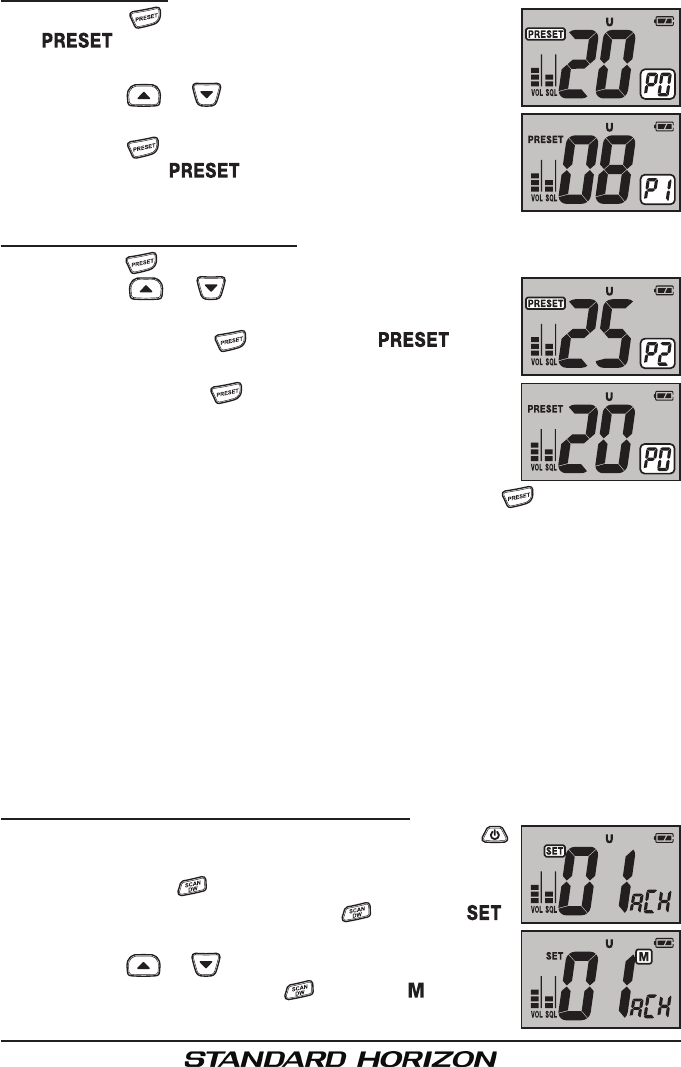
HX300Page 24
6.8.2 OPERATION
1. Press the key to recall the Preset Channel. The
“ ” notation and Preset Channel Number will
appear on the display.
2. Press the or key to select the desired Preset
Channel (“P0” ~ “P9”).
3. Press the key again to return to the last selected
channel. The “ ” notation will disappear from
the display.
6.8.3 Deleting a Preset Channel
1. Press the key to recall the Preset Channel.
2. Press the or key to select the Preset Chan-
nel to be deleted.
3. Press and hold the key until the “ ” nota-
tion is blinking.
4. Press and hold the key again to delete the chan-
nel from the Preset Channel.
5. Repeat steps 2 through 4 to delete the desired chan-
nels from Preset Channels “0” ~ “9”.
6. To nish the deleting the Preset Channel, press the key again to re-
turn to the last selected normal channel.
6.9 SCANNING
The HX300 allows the user to select the scan type from “Memory Scan”
or “Priority Scan”. The “Memory Scan” scans the channels that were pro-
grammed into Scan Memory and also channels stored in the Preset Channel
(“P0” ~ “P9”). The “Priority Scan” is similar to the “Memory Scan” scan. How-
ever, the “Priority Scan” scans the Scan Memory Channel, Preset Channel,
and the Priority Channel (Channel 16). When an incoming signal is detected
on one of the channels during scan, the radio will pause on that channel, al-
lowing you to listen to the incoming transmission.
6.9.1 PROGRAMMING THE SCAN MEMORY
1. Turn the transceiver off by press and holding the
key.
2. Hold down the key, and then turn on the trans-
ceiver while still holding down the key. The “ ”
notation appears on the display.
3. Press the or key to select desired channel to
be scanned, then press the key. The “ ” icon ap-
pears on the display, which indicates the channel has
FCC ID: K6630493X20 / IC: 511B-303493X20
Vertex Standard Co.,Ltd.
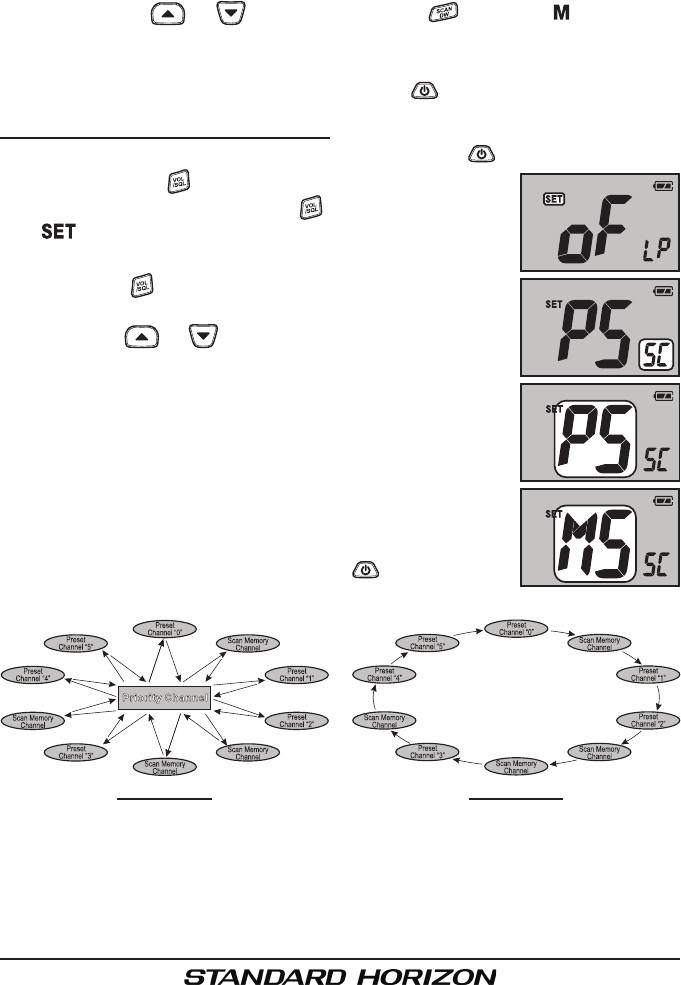
Page 25HX300
been selected to the scan channel.
4. Repeat step 3 for all desired channels to be programmed into scan mem-
ory.
5. To DELETE a channel from the scan memory, select the channel by
pressing the or key, then press the key. The “ ” icon disap-
pears from the display.
6. When you have completed programming scan memory, turn the trans-
ceiver off and on by press and holding the key.
6.9.2 SELECTING THE SCAN TYPE
1. Turn the transceiver off by press and holding the key.
2. Hold down the key, and then turn on the transceiv-
er while still holding down the key.
3. “ ” will appear on the display, indicating the Menu
(“Set”) Mode has been activated.
4. Press the key, repeatedly if necessary to select
the Menu item “SC”.
5. Press the or key to select “PS (Priority Scan)”
or “MS (Memory Scan)”. The factory default is “PS
(Priority Scan)”.
Priority Scan: Scans the Scan Memory Channel,
Preset Channel, and the Priority
Channel (Channel 16).
Memory Scan: Scans the Scan Memory and the Pre-
set Channel.
6. After completing your selection, turn the transceiver
off and on by press and holding the key.
MeMory ScanPriority Scan
FCC ID: K6630493X20 / IC: 511B-303493X20
Vertex Standard Co.,Ltd.
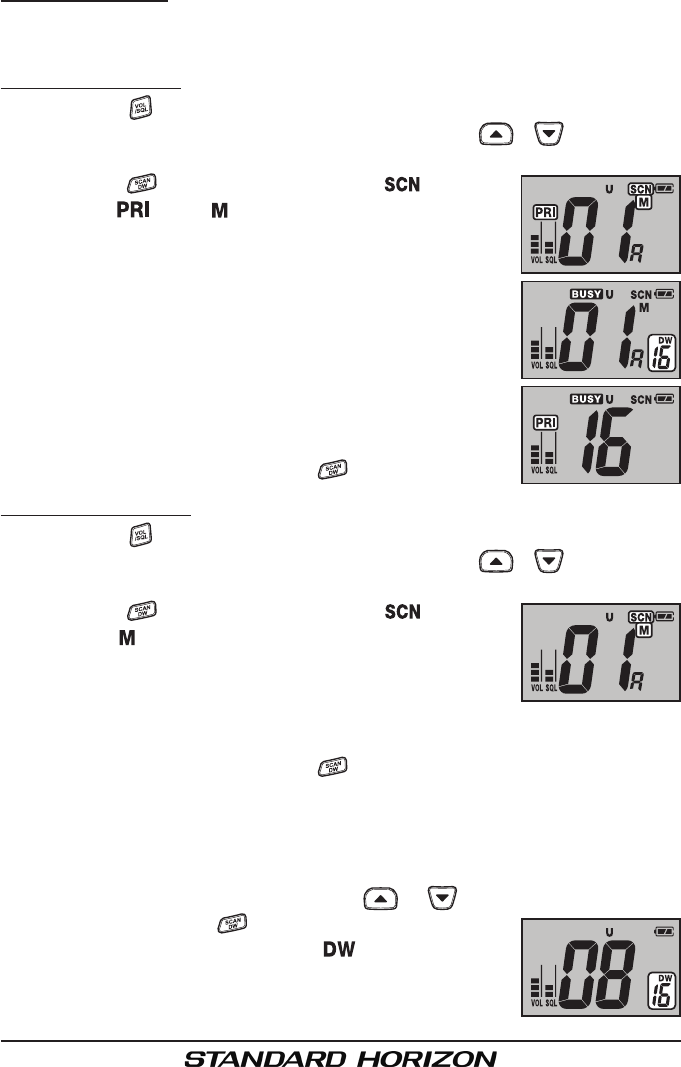
HX300Page 26
6.9.3 OPERATION
The operation of the “Priority Scan” or “Memory Scan” is determined via the
section “6.9.2 SELECTING THE SCAN TYPE”
6.9.3.1 Priority Scan
1. Press the key several times until the “SQL” indicator blinks, to acti-
vate the squelch adjusting mode, then press the / key until the
background noise disappears.
2. Press the key to start scanning, a “ ” icon and
blinking “ ” and “ ” icons will appears on the dis-
play during scanning.
3. When the HX300 receives a transmission on a work-
ing channel, it will stop on the working channel and
“Dual Watch” (described in next chapter) to the prior-
ity channel until the incoming signal disappears, then
start scanning again.
4. When the HX300 receives a signal on the Priority
channel it will stay on this channel until the incoming
signal disappears, then start Priority scanning again.
5. To stop the scanning, press the key.
6.9.3.2 Memory Scan
1. Press the key several times until the “SQL” indicator blinks, to acti-
vate the squelch adjusting mode, then press the / key until the
background noise disappears.
2. Press the key to start scanning, a “ ” icon and
blinking “ ” icon will appears on the display during
scanning.
3. When the HX300 receives a transmission, it will stop
on the channel until the incoming signal disappears, then start scanning
again.
4. To stop the scanning, press the key.
6.10 DUAL WATCH
The Dual Watch feature allows the radio watch the Priority Channel (Channel
16) and one other channel.
1. Select the desired channel using the or key.
2. Press and hold the key for two seconds to acti-
vate the Dual Watch feature. A “ ” icon will appear
on the display when the Dual Watch feature is acti-
vated.
FCC ID: K6630493X20 / IC: 511B-303493X20
Vertex Standard Co.,Ltd.
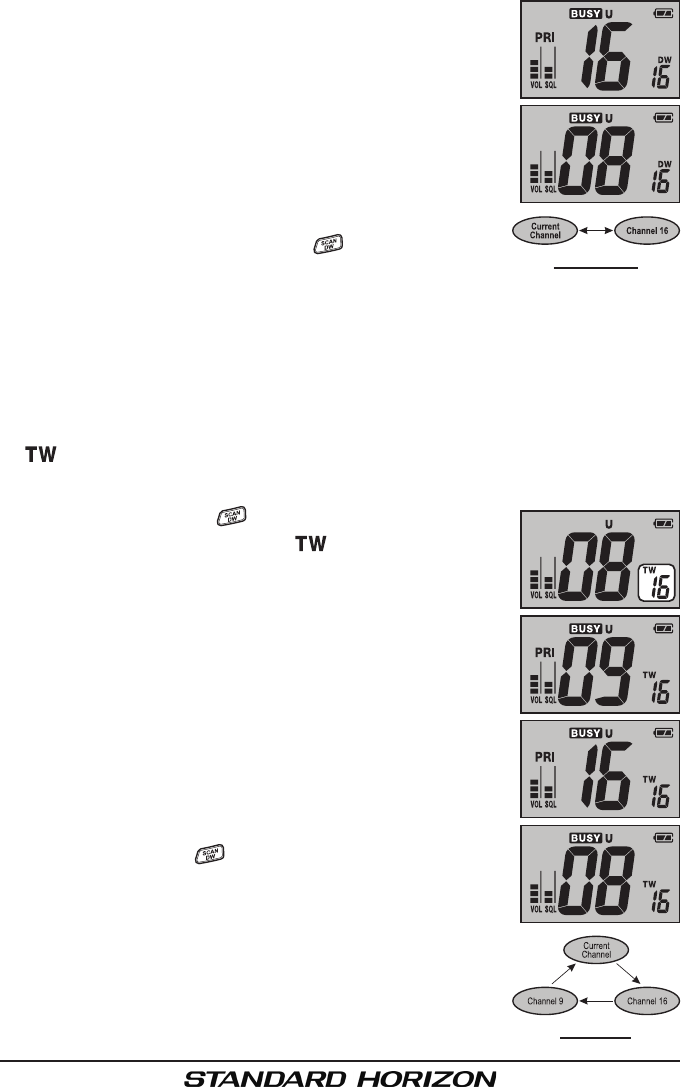
Page 27HX300
3. When a transmission is received on the “Priority
Channel”, the radio receives the “Priority Channel”
until the incoming signal disappears.
4. When the HX300 receives a transmission on the work-
ing channel, the radio will dual watch between the
working channel and Priority Channel (Channel 16).
5. The Dual Watch feature will resume when the incom-
ing signal disappears at the end of the transmission.
6. To stop the Dual Watch feature and return to normal
operation, press and hold the key for two sec-
onds again.
6.11 TRI-WATCH
You may change the Dual Watch feature to Tri-Watch via the Menu (“Set”)
Mode. Refer to Menu Mode Item “dt (DUAL WATCH MODE)” on page 29 for
details.
The Tri-Watch scans Channel 16, 9, and one other channel. When enabled,
a “ ” icon will appear on the display when the Dual Watch feature is acti-
vated.
1. Press and hold the key for two seconds to acti-
vate the TRI-Watch feature. “ ” icon will appear on
the display when the Tri-Watch feature is activated.
2. When a transmission is received on the channel 16,
HX300 will stay on the channel 16 until the incoming
signal disappears.
3. When a transmission is received on the channel 9,
the HX300 will Dual watch between the channel 16
and channel 9.
4. When the HX300 receives a transmission on the
working channel, the HX300 will Tri-watch between
the working channel, channel 16, and channel 9.
5. To stop the Tri-watch feature and return to normal op-
eration, press the key.
Dual Watch
tri Watch
FCC ID: K6630493X20 / IC: 511B-303493X20
Vertex Standard Co.,Ltd.
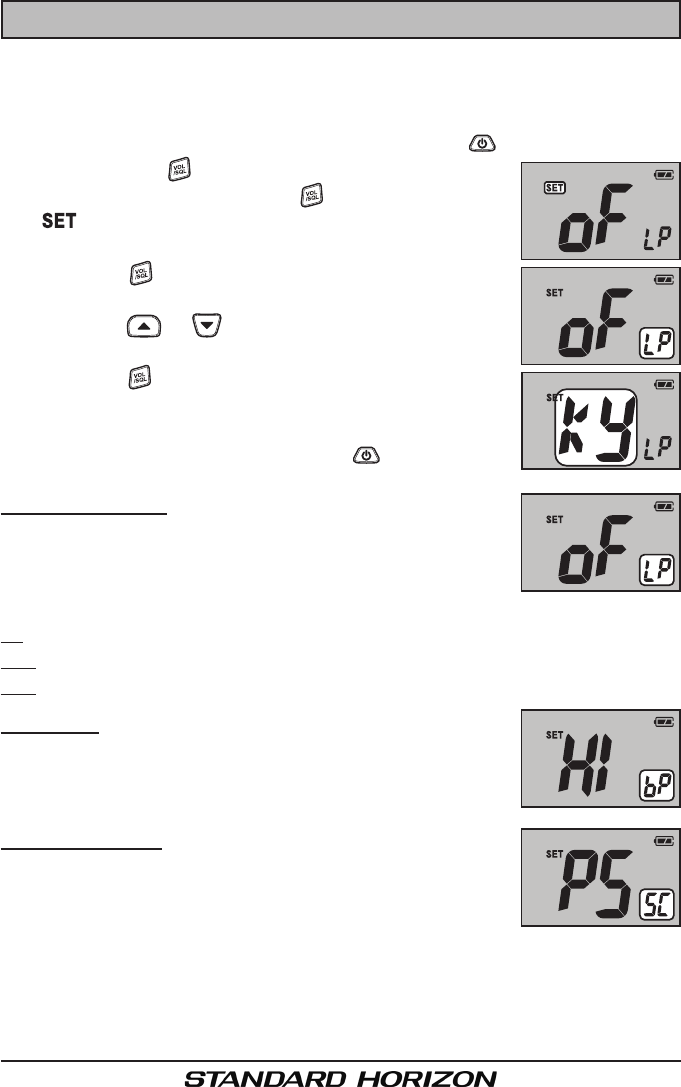
HX300Page 28
7. MENU (“SET”) MODE
The HX300’s Menu Mode allows a number of the HX300 operating param-
eters to be custom-congured for your operating requirements.
The Menu Mode is easy to activate and set, using the following procedure:
1. Turn the transceiver off by press and holding the key.
2. Hold down the key, and then turn on the transceiv-
er while still holding down the key.
3. “ ” will appear on the display, indicating the Menu
(“Set”) Mode has been activated.
4. Press the key to select the Menu item to be ad-
justed.
5. Press the or key to enable adjustment of the
selected Menu item. The menu item will blink.
6. Press the key to select the status or value of the
Menu item.
7. After completing your adjustment, turn the transceiver
off and on by press and holding the key.
LP (LAMP MODE)
Function: Selects the Lamp illumination method for the
LCD/Keypad.
Available Values: on / kEY / oFF
Default: kEY
on: Illuminates the LCD/Keypad continuously.
kEY: Illuminates the LCD/Keypad for 5 seconds when any key is pressed.
oFF: Turns off the backlight for the LCD and keys.
bP (BEEP)
Function: Enable/Disable the Keypad beeper.
Available Values: HI / Lo / oFF
Default: HI
SC (SCAN TYPE)
Function: Selects the Scan mode.
Available Values: PS (Priority Scan) / MS (Memory
Scan)
Default: PS (Priority Scan)
FCC ID: K6630493X20 / IC: 511B-303493X20
Vertex Standard Co.,Ltd.
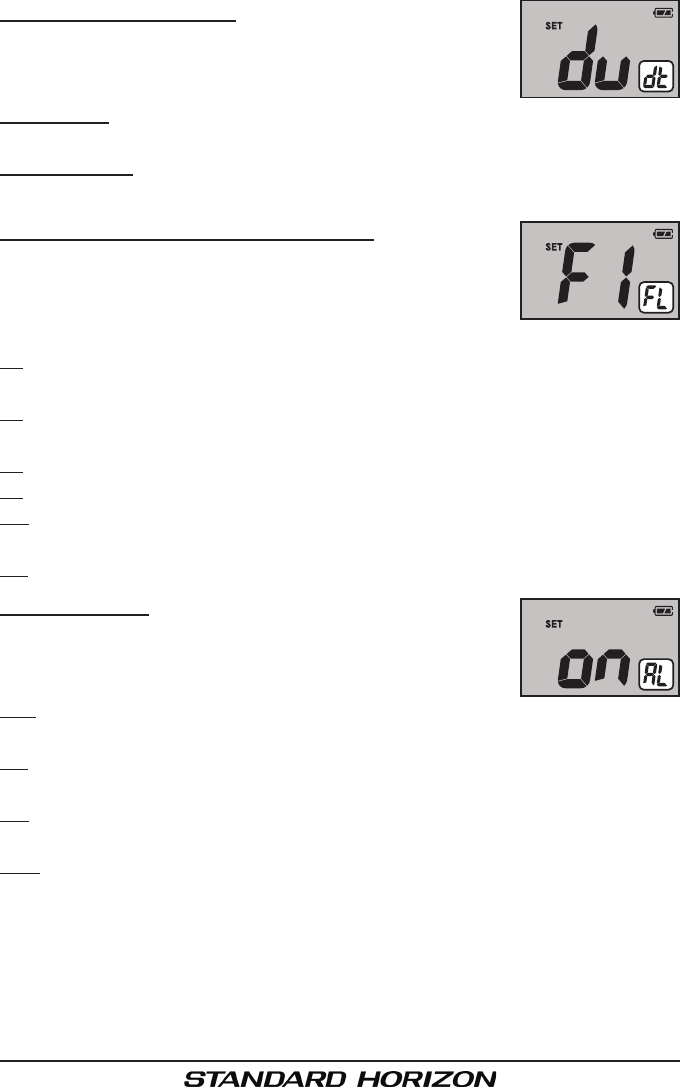
Page 29HX300
dt (DUAL WATCH MODE)
Function: Selects dual or tri-watch as desired.
Available Values: d (Dual Watch) / t (Tri Watch)
Default: d (Dual Watch)
t (Tri Watch): The HX300 watches the activity of Channel 16, Channel 9,
and the current channel.
d (Dual Watch): The HX300 watches the activity of the current channel and
the Channel 16.
FL (WATER HAZARD LAMP FUNCTION)
Function: Selects the operation mode of the Water Haz-
ard Lamp when the HX300 fell in water.
Available Values: F1 / F2 / F3 / F4 / SO (SOS) / OF (OFF)
Default: F1
F1: The Water Hazard Lamp blinks slowly when the when the HX300 fell in
water.
F2: The Water Hazard Lamp blinks rapidly when the when the HX300 fell in
water.
F3: The Water Hazard Lamp blinks when the when the HX300 fell in water.
F4: The Water Hazard Lamp ashes when the when the HX300 fell in water.
SO: The Water Hazard Lamp ushes according to the “S.O.S” Morse Code
( --- ) when the HX300 fell in water.
OF: Disables the Water Hazard Lamp.
AL (WX ALERT)
Function: Enable/Disable the Weather Alert feature.
Available Values: ALL / SC / CH / OFF
Default: SC
ALL: When on a weather channel, the HX300 will alarm when the Weather
Alert is received.
SC: Emits a loud beep when the Weather Alert is received while scanning
the Weather channels.
CH: Emits a loud beep when the Weather Alert is received while receiving
the Weather channel and/or scanning the Weather channels.
OFF: Disables the Weather Alert function.
FCC ID: K6630493X20 / IC: 511B-303493X20
Vertex Standard Co.,Ltd.

HX300Page 30
8. MAINTENANCE
8.1 GENERAL
The inherent quality of the solid-state components in STANDARD HORIZON
radios will provide many years of continuous use. Take the following precau-
tions to prevent damage to the radio.
To prevent corrosion of electrical contacts and keep the water resistance,
keep the microphone connected or the jack covered at all times.
Never key the transmitter unless an antenna or suitable dummy load is
connected to the antenna receptacle.
Ensure that the input voltage does not exceed the value specied in your
Owner’s Manual.
Use only STANDARD HORIZON-approved accessories and replacement
parts.
8.2 REPLACEMENT PARTS
Occasionally an owner needs a replacement part. These can be ordered
from our Parts Department by writing or calling (in USA or Canada), or Stan-
dard Horizon/Vertex Standard authorized dealers (outside USA or Canada).
Marine Division of Vertex Standard
US Headquarters
6125 Phyllis Drive, Cypress, California 90630, U.S.A.
Telephone (714) 827-7600
Commonly requested parts, and their part numbers are listed below.
VOL Knob: RA1078700
CAT460 Antenna: Q3000176
PA-54B USB Wall Charger: AAJ41X001
Charger Cable: T9101606
Battery Cover: RA1377600
CLIP-22 Belt Clip: AAH97X001
Hand Strap: S6000418
FCC ID: K6630493X20 / IC: 511B-303493X20
Vertex Standard Co.,Ltd.
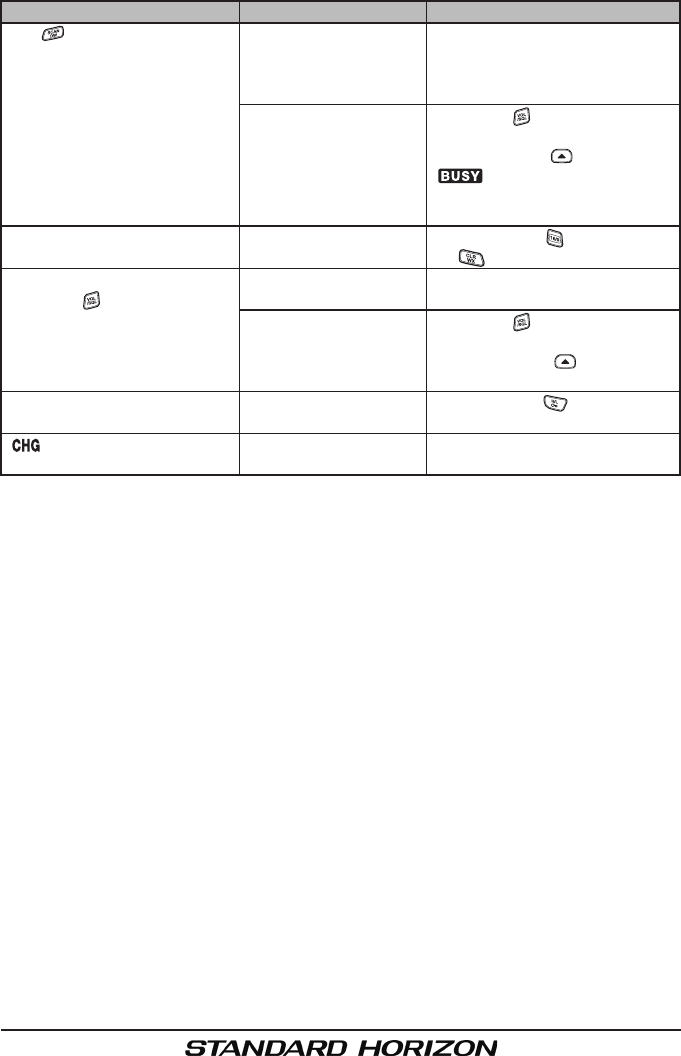
Page 31HX300
8.3 TROUBLESHOOTING CHART
SYMPTOM PROBABLE CASE REMEDY
The key does not start the
scan.
No channel memorized. Enter desired channels into the
transceiver’s Scan memory. Refer
to section 6.10.1 “PROGRAM-
MING THE SCAN MEMORY”.
Squelch is not adjusted. Press the key several times
until the “SQL” indicator blinks,
then press the key until the
“ ” icon disappears. Further
adjustment of the squelch level
may eliminate incoming signal.
Cannot select between USA,
INTL, Canadian bands.
Proper operation not fol-
lowed.
Hold down the key and press
the key.
Speaker audio is not heard
when the key is press and
hold.
Low battery. Charge battery. Refer to section
4.2.3 “BATTERY CHARGING”.
Audio volume is too low. Press the key several times
until the “VOL” indicator blinks,
then press the key several
times.
Some keys does not operate. Key lock is on. Hold down the key for 2 sec-
onds to turn the Key Lock off.
“ ” indicator on the LCD does
not appear while charging.
Detective battery FNB-
122LI.
Contact your Standard Horizon
dealer.
FCC ID: K6630493X20 / IC: 511B-303493X20
Vertex Standard Co.,Ltd.

HX300Page 32
9. VHF MARINE CHANNEL ASSIGNMENTS
Tables on the following columns list the VHF Marine Channel assignments
for U.S.A. and International use. Below are listed some data about the
charts.
1. VTS. Where indicated, these channels are part of the U.S. Coast Guard’s
Vessel Trafc System.
2. Alpha channel numbers, that is, channel numbers followed by the letter A
(such as Channel 07A) are simplex channels on the U.S.A. or Canadian
channel assignments whose counterparts in the International assign-
ments are duplex channels. International channels do not use “alpha”
numbers. If you call the Coast Guard on Channel 16, they will sometimes
ask you to “go to channel 22 Alpha.” This is a channel assigned to U.S.A,
and Canadian Coast Guards for handling distress and other calls. If your
radio is set for International operation you will go to Channel 22 instead
of 22A, and will not be able to communicate with the Coast Guard. To
use Channel 22A, your radio must be set for USA or Canada operation,
usually by a U/I/C (USA/International/Canada) control or combination of
controls. Channel 22 (without an “A”) is an International duplex channel
for port operations. Some radios indicate an “A” adjacent to the alpha
channels on the display; on others “alpha” is not indicated but the proper
channel is selected based on the U/I/C setting.
3. Bridge-to-Bridge channels (for example, Channel 13) are for use by
bridge operators on inter-coastal waterways and rivers. It is also used by
marine vessels in the vicinity of these bridges for navigation and for com-
municating with the bridge operators. Note that a limit of 1 Watt is speci-
ed for these channels.
4. The S/D column on the chart indicates either S (simplex) or D (duplex).
Simplex means transmitting and receiving on the same frequency. Only
one party at a time can talk, unlike a telephone. Be sure to say “over”
and release your microphone push-to-talk switch at the end of each
transmission. Duplex operation involves the use of one frequency for
transmitting and a separate frequency for receiving. On channels speci-
ed as duplex on the charts, correct mode of operation is established au-
tomatically by your radio when you select a channel; you cannot change
the mode. And you still must release the push-to-talk switch after each
transmission in order to listen to the radio.
5. Channels normally used by recreational boaters are those that include
the term “non-commercial” in the Channel Use column of the chart.
Some of these are shared with other users and some are used only in
FCC ID: K6630493X20 / IC: 511B-303493X20
Vertex Standard Co.,Ltd.

Page 33HX300
certain geographic regions.
6. Marine vessels equipped with VHF radios are required to monitor Chan-
nel 16.
7. 156.050 MHz and 156.175 MHz are available for port operations and
commercial communications purposes when used only within the U.S.
Coast Guard designated Vessel Trafc Services (VTS) area of New Or-
leans, on the lower Mississippi River from the various pass entrances
in the Gulf of Mexico to Devil’s Swamp Light at River Mile 242.4 above
head of passes near Baton Rouge.
8. 156.250 MHz is available for port operations communications use only
within the U.S. Coast Guard designated VTS radio protection areas of
New Orleans and Houston described in Sec. 80.383. 156.250 MHz is
available for intership port operations communications used only within
the area of Los Angeles and Long Beach harbors, within a 25- nautical
mile radius of Point Fermin, California.
9. 156.550 MHz, 156.600 MHz and 156.700 MHz are available in the U.S.
Coast Guard designated port areas only for VTS communications and
in the Great Lakes available primarily for communications relating to the
movement of ships in sectors designated by the St. Lawrence Seaway
Development Corporation or the U.S. Coast Guard. The use of these fre-
quencies outside VTS and ship movement sector protected areas is per-
mitted provided they cause no interference to VTS and ship movement
communications in their respective designated sectors.
10. Use of 156.875 MHz is limited to communications with pilots regarding
the movement and docking of ships. Normal output power must not ex-
ceed 1 watt. 5: 156.375 MHz and 156.650 MHz are available primarily for
intership navigational communications. These frequencies are available
between coast and ship on a secondary basis when used on or in the
vicinity of locks or drawbridges. Normal output power must not exceed 1
watt. Maximum output power must not exceed 10 watts for coast stations
or 25 watts for ship stations.
11. On the Great Lakes, in addition to bridge-to-bridge communications,
156.650 MHz is available for vessel control purposes in established
vessel trafc systems. 156.650 MHz is not available for use in the Mis-
sissippi River from South Pass Lighted Whistle Buoy “2” and Southwest
Pass entrance Mid-channel Lighted Whistle Buoy to mile 242.4 above
Head of Passes near Baton Rouge. Additionally it is not available for use
in the Mississippi River-Gulf Outlet, the Mississippi River-Gulf Outlet Ca-
nal, and the Inner Harbor Navigational Canal, except to aid the transition
from these areas.
FCC ID: K6630493X20 / IC: 511B-303493X20
Vertex Standard Co.,Ltd.

HX300Page 34
12. Use of 156.375 MHz is available for navigational communications only
in the Mississippi River from South Pass Lighted Whistle Buoy “2” and
Southwest Pass entrance Mid channel Lighted Whistle Buoy to mile
242.4 above head of Passes near Baton Rouge, and in addition over the
full length of the Mississippi River-Gulf Outlet Canal from entrance to its
junction with the Inner Harbor Navigation Canal, and over the full length
of the Inner Harbor Navigation Canal from its junction with the Mississippi
River to its entry to Lake Pontchartrain at the New Seabrook vehicular
bridge.
13. Within 120 km (75 miles) of the United States/Canada border, in the area
of the Puget Sound and the Strait of Juan de Fuca and its approaches,
157.425 MHz is half of the duplex pair designated as Channel 88. In this
area, Channel 88 is available to ship stations for communications with
public coast stations only. More than 120 km (75 miles) from the United
States/Canada border in the area of the Puget Sound and the Strait of
Juan de Fuca, its approaches, the Great Lakes, and the St. Lawrence
Seaway, 157.425 MHz is available for intership and commercial commu-
nications. Outside Puget Sound area and its approaches and the Great
Lakes, 157.425 MHz is also available for communications between com-
mercial shing vessels and associated aircraft while engaged in commer-
cial shing activities.
14. When the frequency 156.850 MHz is authorized, it may be used addition-
ally for search and rescue training exercises conducted by state or local
governments.
15. The frequency 156.850 MHz is additionally available to coast stations on
the Great Lakes for transmission of scheduled Coded Marine Weather
Forecasts (MAFOR), Great Lakes Weather Broadcast (LAWEB) and
scheduled Notices to Mariners or Bulletins. F3C and J3C emissions are
permitted. Coast Stations on the Great Lakes must cease weather broad-
casts which cause interference to stations operating on 156.800 MHz
until the interference problem is resolved.
16. The frequency 157.100 MHz is authorized for search and rescue train-
ing exercises by state or local government in conjunction with U.S. Coast
Guard stations. Prior U.S. Coast Guard approval is required. Use must
cease immediately on U.S. Coast Guard request.
17. The duplex pair for channel 20 (157.000/161.600 MHz) may be used for
ship to coast station communications.
18. Available for assignment to coast stations, the use of which is in accord
with an agreed program, for the broadcast of information to ship stations
concerning the environment.
FCC ID: K6630493X20 / IC: 511B-303493X20
Vertex Standard Co.,Ltd.
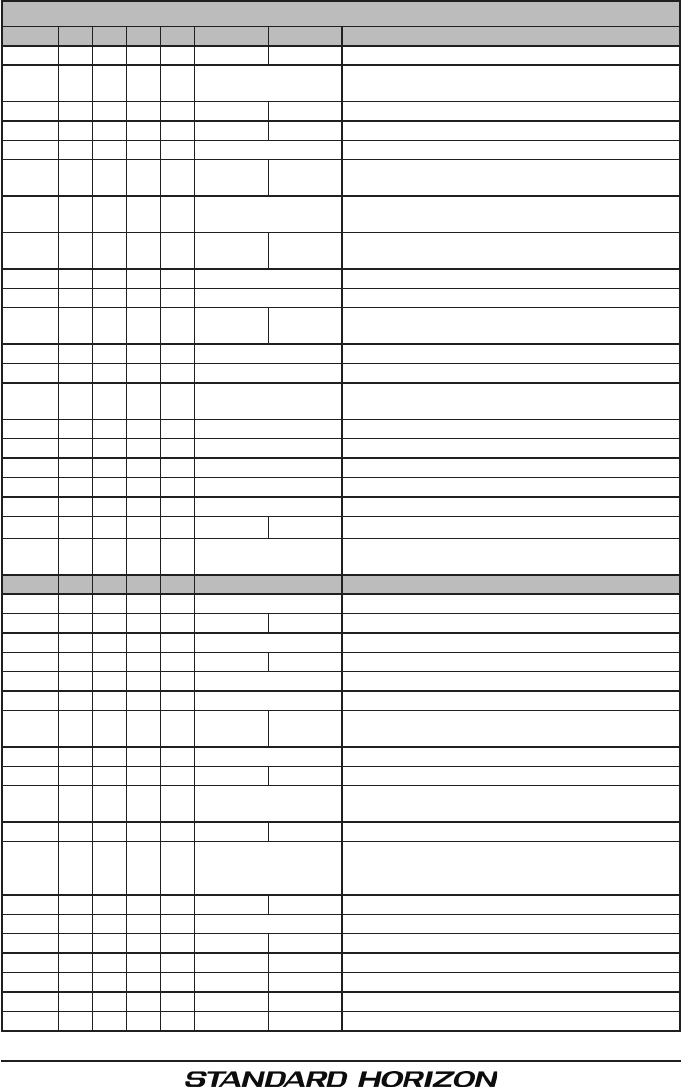
Page 35HX300
VHF MARINE CHANNEL CHART
CH U C I S/D TX RX CHANNEL USE
01 X X D 156.050 160.650 Public Correspondence (Marine Operator)
01A X S 156.050 Port Operation and Commercial.
VTS in selected areas
02 X X D 156.100 160.700 Public Correspondence (Marine Operator)
03 X X D 156.150 160.750 Public Correspondence (Marine Operator)
03A X S 156.150 U.S. Government Only, Coast Guard
04 X D 156.200 160.800 Public Correspondence (Marine Operator),
Port operation, ship movement
04A X S 156.200 Pacic coast: Coast Guard, East Coast:
Commercial shing
05 X D 156.250 160.850 Public Correspondence (Marine Operator),
Port operation, ship movement
05A X X S 156.250 Port operation. VTS in Seattle
06 X X X S 156.300 Inter-ship Safety
07 X D 156.350 160.950 Public Correspondence (Marine Operator),
Port operation, ship movement
07A X X S 156.350 Commercial
08 X X X S 156.400 Commercial (Inter-ship only)
09 X X X S 156.450 Boater Calling channel, Commercial &
Non-commercial (Recreational)
10 X X X S 156.500 Commercial
11 X X X S 156.550 Commercial. VTS in selected areas
12 X X X S 156.600 Port operation. VTS in selected areas
13 X X X S 156.650 Inter-ship Navigation Safety (Bridge-to-bridge)
14 X X X S 156.700 Port operation. VTS in selected areas
15 X S - - - 156.750 Environmental (Receive only)
15 X X S 156.750 Commercial, non-commercial,
ship movement (1 W)
16 X X X S 156.800 International Distress, Safety and Calling
17 X X X S 156.850 State Controlled (1 W)
18 X D 156.900 161.500 Port operation, ship movement
18A X X S 156.900 Commercial
19 X D 156.950 161.550 Port operation, ship movement
19A X S 156.950 US: Commercial
19A X S 156.950 Coast Guard
20 X X X D 157.000 161.600 Canadian Coast Guard Only,
International: port operations and shipment
20A X S 157.000 Port operation
21 X D 157.050 161.650 Port operation, ship movement
21A X X S 157.050 U.S. Government Only,
Canadian Coast Guard
22 X D 157.100 161.700 Port operation, ship movement
22A X X S 157.100 US and Canadian Coast Guard Liaison
and aritime Safety Information Broadcasts
announced on channel 16
23 X X D 157.150 161.750 Public Correspondence (Marine Operator)
23A X S 157.150 U.S. Government Only
24 X X X D 157.200 161.800 Public Correspondence (Marine Operator)
25 X X X D 157.250 161.850 Public Correspondence (Marine Operator)
26 X X X D 157.300 161.900 Public Correspondence (Marine Operator)
27 X X X D 157.350 161.950 Public Correspondence (Marine Operator)
28 X X X D 157.400 162.000 Public Correspondence (Marine Operator)
FCC ID: K6630493X20 / IC: 511B-303493X20
Vertex Standard Co.,Ltd.
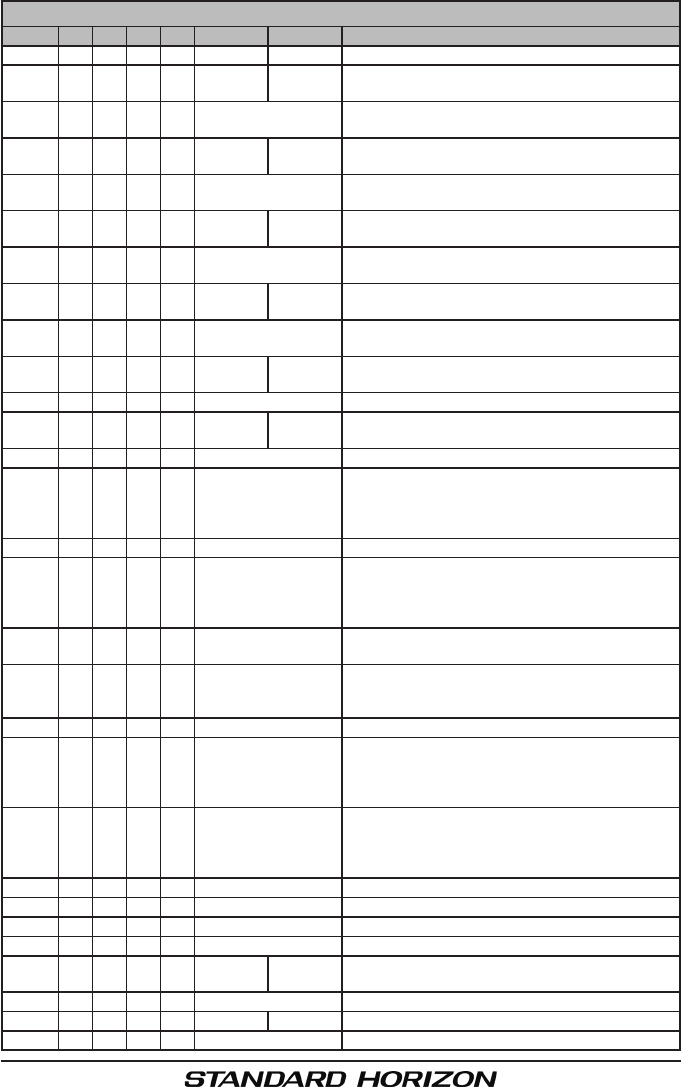
HX300Page 36
VHF MARINE CHANNEL CHART
CH U C I S/D TX RX CHANNEL USE
60 X X D 156.025 160.625 Public Correspondence (Marine Operator)
61 X D 156.075 160.675 Public Correspondence (Marine Operator),
Port operation, ship movement
61A X X S 156.075 Public Coast: Coast Guard;
East Coast: commercial shing only
62 X D 156.125 160.725 Public Correspondence (Marine Operator),
Port operation, ship movement
62A X S 156.125 Public Coast: Coast Guard;
East Coast: commercial shing onl
63 X D 156.175 160.775 Public Correspondence (Marine Operator),
Port operation, ship movement
63A X X S 156.175 Port Operation and Commercial.
VTS in selected areas
64 X X D 156.225 160.825 Public Correspondence (Marine Operator),
Port operation, ship movement
64A X X S 156.225 Public Correspondence (Marine Operator),
Port operation, ship movement
65 X D 156.275 160.875 Public Correspondence (Marine Operator),
Port operation, ship movement
65A X X S 156.275 Port Operations
66 X D 156.325 160.925 Public Correspondence (Marine Operator),
Port operation, ship movement
66A X X S 156.325 Port Operations
67 X X X S 156.375 US: Commercial.
Used for Bridge-to-bridge communi-cations in
lower Mississippi River. Inter-ship only,
Canada: Commercial shing, S&R
68 X X X S 156.425 Non-commercial (Recreational)
69 X X X S 156.475 US: Non-commercial (Recreational),
Canada: Commercial shing only,
International: Inter-ship, Port operations and
Ship movement
70 X X X S 156.525 Digital selective calling
(voice communications not allowed)
71 X X X S 156.575 US, Canada: Non-commercial (Recreational),
International: Port operations and Ship
movement
72 X X X S 156.625 Non-commercial (Inter-ship only)
73 X X X S 156.675 US: Port Operations,
Canada: Commercial shing only,
International: Inter-ship, Port operations and
Ship movement
74 X X X S 156.725 US: Port Operations,
Canada: Commercial shing only,
International: Inter-ship, Port operations and
Ship movement
75 X X X S 156.775 Port Operations (Inter-ship only) (1W)
76 X X X S 156.825 Port Operations (Inter-ship only) (1W)
77 X X S 156.875 Port Operations (Inter-ship only) (1W)
77 X S 156.875 Port Operations (Inter-ship only)
78 X D 156.925 161.525 Public Correspondence (Marine Operator),
Port operation, ship-movement
78A X X S 156.925 Non-commercial (Recreational)
79 X D 156.975 161.575 Port operation and Ship movement
79A X X S 156.975 Commercial
FCC ID: K6630493X20 / IC: 511B-303493X20
Vertex Standard Co.,Ltd.
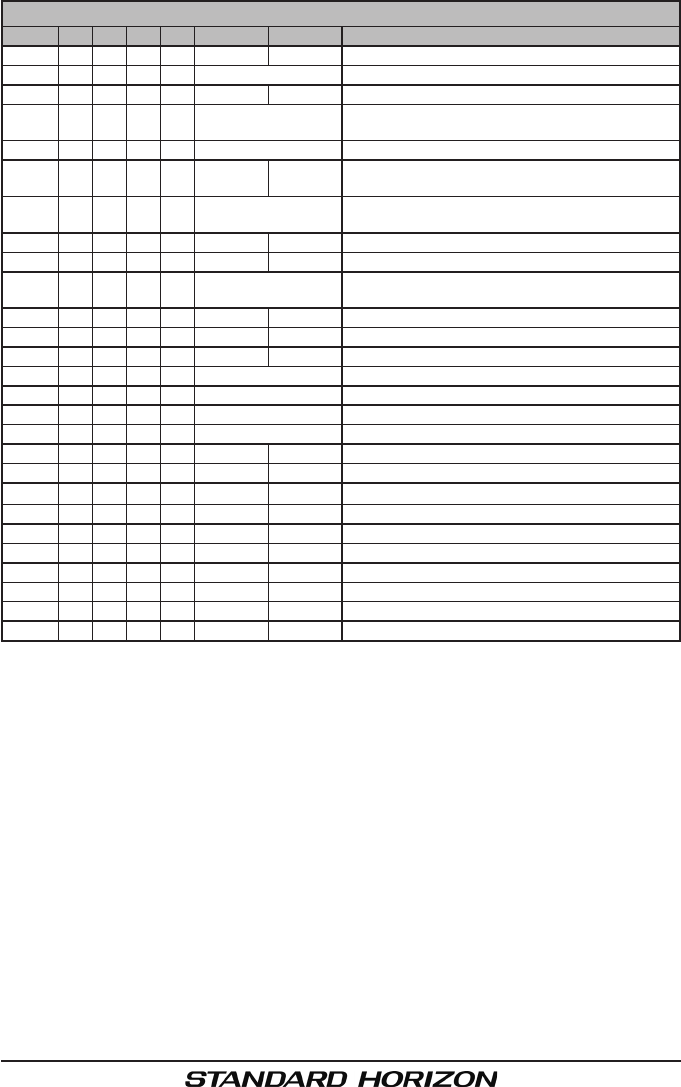
Page 37HX300
NOTE: Simplex channels, 03A, 21A, 23A, 61A, 64A, 81A, 82A and 83A CANNOT be lawfully
used by the general public in U.S.A. waters.
VHF MARINE CHANNEL CHART
CH U C I S/D TX RX CHANNEL USE
80 X D 157.025 161.625 Port operation, ship movement
80A X X S 157.025 Commercial
81 X D 157.075 161.675 Port operation, ship movement
81A X S 157.075 U.S. Government Only -
Environmental protection operations
81A X S 157.075 Canadian Coast Guard Only
82 X D 157.125 161.725 Public Correspondence (Marine Operator),
Port operation, ship movement
82A X X S 157.125 U.S. Government Only,
Canadian Coast Guard Only
83 X D 157.175 161.775 Canadian Coast Guard Only
83 X D 157.175 161.775 Public Correspondence (Marine Operator)
83A X X S 157.175 U.S. Government Only,
Canadian Coast Guard Only
84 X X X D 157.225 161.825 Public Correspondence (Marine Operator)
85 X X X D 157.275 161.875 Public Correspondence (Marine Operator)
86 X X X D 157.325 161.925 Public Correspondence (Marine Operator)
87 X X S 157.375 Port operation, ship movement
87A X S 157.375 Public Correspondence (Marine Operator)
88 X X S 157.425 Port operation, ship movement
88A X S 157.425 Commercial, Inter-ship Only
WX01 X X X D - - - 162.550 Weather (receive only)
WX02 X X X D - - - 162.400 Weather (receive only)
WX03 X X X D - - - 162.475 Weather (receive only)
WX04 X X X D - - - 162.425 Weather (receive only)
WX05 X X X D - - - 162.450 Weather (receive only)
WX06 X X X D - - - 162.500 Weather (receive only)
WX07 X X X D - - - 162.525 Weather (receive only)
WX08 X X X D - - - 161.650 Weather (receive only)
WX09 X X X D - - - 161.775 Weather (receive only)
WX10 X X X D - - - 163.275 Weather (receive only)
FCC ID: K6630493X20 / IC: 511B-303493X20
Vertex Standard Co.,Ltd.

HX300Page 38
10. WARRANTY
Marine Products Limited Warranty
PLEASE NOTE
The following “Limited Warranty” is for valid for products that have
been purchased in the United States and Canada. For limited Warran-
ty details outside the United States, contact the dealer in your country.
STANDARD HORIZON (a division of VERTEX STANDARD) warrants, to
the original purchaser only, each new Marine Communications Product
(“Product”) manufactured and/or supplied by STANDARD HORIZON against
defects in materials and workmanship under normal use and service for a
period of time from the date of purchase as follows:
Fixed Mount and Portable Transceivers
1 year - if purchased before 01/01/91
3 years - if purchased between 01/01/91 and 01/01/94
3 years Waterproof - if purchased after 01/01/94
Loud hailers
1 year - if purchased before 01/01/91
3 years - if purchased after 01/01/91
Associated Chargers
1 year - if purchased before 01/01/91
3 years - if purchased after 01/01/91
Associated Batteries - 1 year. Note: Batteries will be deemed defective only
if storage capacity drops below 80% of rated capacity or if leakage develops.
Associated Accessories - 1 year. Includes: Microphones/Handsets, Exter-
nal Speakers, Antennas, Carrying Accessories, Power Supplies, and Signal-
ing Boards.
To receive warranty service, the purchaser must deliver the Product, transpor-
tation and insurance prepaid, to STANDARD HORIZON (a division of VER-
TEX STANDARD). Include proof of purchase indicating model. serial number,
and date of purchase. STANDARD HORIZON will return the Product to the
purchaser freight prepaid. Products purchased prior to January 1, 1991 will
bear the STANDARD HORIZON warranty terms in effect prior to that date.
In the event of a defect, malfunction or failure of the Product during the war-
ranty period, STANDARD HORIZON’s liability for any breach of contract or
any breach of express or implied warranties in connection with the sale of
Products shall be limited solely to repair or replacement, at its option, of the
Product or part(s) therein which, upon examination by STANDARD HORI-
FCC ID: K6630493X20 / IC: 511B-303493X20
Vertex Standard Co.,Ltd.

Page 39HX300
ZON, appear to be defective or not up to factory specications. STANDARD
HORIZON may, at its option, repair or replace parts or subassemblies with
new or reconditioned parts and subassemblies. Parts thus repaired or re-
placed are warranted for the balance of the original applicable warranty.
STANDARD HORIZON will not warrant installation, maintenance or service
of the Products. In all instances, STANDARD HORIZON’s liability for dam-
ages shall not exceed the purchase price of the defective Product.
This warranty only extends to Products sold within the 50 States of the Unit-
ed States of America and the District of Columbia.
STANDARD HORIZON will pay all labor to repair the product and replace-
ment parts charges incurred in providing the warranty service except where
purchaser abuse or other qualifying exceptions exist. The purchaser must
pay any transportation expenses incurred in returning the Product to STAN-
DARD HORIZON for service.
This limited warranty does not extend to any Product which has been sub-
jected to misuse, neglect, accident, incorrect wiring by anyone other than
STANDARD HORIZON, improper installation, or subjected to use in violation
of instructions furnished by STANDARD HORIZON, nor does this warranty
extend to Products on which the serial number has been removed, defaced,
or changed. STANDARD HORIZON cannot be responsible in any way for an-
cillary equipment not furnished by STANDARD HORIZON which is attached
to or used in connection with STANDARD HORIZON’s Products, or for the
operation of the Product with any ancillary equipment, and all such equip-
ment is expressly excluded from this warranty. STANDARD HORIZON dis-
claims liability for range, coverage, or operation of the Product and ancillary
equipment as a whole under this warranty. STANDARD HORIZON reserves
the right to make changes or improvements in Products, during subsequent
production, without incurring the obligation to install such changes or im-
provements on previously manufactured Products.
The implied warranties which the law imposes on the sale of this Product are
expressly LIMITED, in duration, to the time period specied above. STAN-
DARD HORIZON shall not be liable under any circumstances for consequen-
tial damages resulting from the use and operation of this Product, or from
the breach of this LIMITED WARRANTY, any implied warranties, or any con-
tract with STANDARD HORIZON. IN CONNECTION WITH THE SALE OF
ITS PRODUCTS, STANDARD HORIZON MAKES NO WARRANTIES, EX-
PRESS OR IMPLIED AS TO THE MERCHANTABILITY OR FITNESS FOR A
PARTICULAR PURPOSE OR OTHERWISE, EXCEPT AS EXPRESSLY SET
FORTH HEREIN.
FCC ID: K6630493X20 / IC: 511B-303493X20
Vertex Standard Co.,Ltd.

HX300Page 40
Some states do not allow the exclusion or limitation of incidental or conse-
quential damages, or limitation on how long an implied warranty lasts, so the
above limitations or exclusions may not apply. This warranty gives specic
legal rights, and there may be other rights which may vary from state to state.
ONLY PRODUCTS SOLD ON OR AFTER JANUARY 1, 1991 ARE COV-
ERED UNDER THE TERMS OF THIS LIMITED WARRANTY.
ON-LINE WARRANTY REGISTRATION
THANK YOU for buying STANDARD HORIZON (a division of Vertex
Standard) products! We are condent your new radio will serve your
needs for many years!
Please visit www.standardhorizon.com to register the HX300 Marine
VHF. It should be noted that visiting the Web site from time to time
may be benecial to you, as new products are released they will ap-
pear on the STANDARD HORIZON Web site.
Product Support Inquiries
If you have any questions or comments regarding the use of the
HX300, you can visit the STANDARD HORIZON Web site to send
an E-mail or contact the Product Support team at (714) 827-7600 ext
6300 M-F 8:00-5:00PST.
In addition to the warranty, STANDARD HORIZON includes a lifetime
"at rate" program to provide service after the warranty period has ex-
pired. If you wish to obtain the at rate price for out-of-warranty repair,
you must include the information on the Owner’s Record with the unit
when you return it to your Dealer or to STANDARD HORIZON.
Lifetime Flat Rate Service Program: For the original Owner only, for
the lifetime of the unit, STANDARD HORIZON will repair the unit to
original specications.
Note: The at rate amount is payable by the Owner only if STAN-
DARD HORIZON or the STANDARD HORIZON Dealer determines
that a repair is needed. After the repair, a 90-day warranty will be in
effect from the date of return of the unit to the .Owner.
This service program is not available for equipment which has failed
as a result of neglect, accident, breakage, misuse, improper installa-
tion or modication, or water damage (depending on the product).
FCC ID: K6630493X20 / IC: 511B-303493X20
Vertex Standard Co.,Ltd.

Page 41HX300
11. SPECIFICATIONS
Performance specications are nominal, unless otherwise indicated, and are
subject to change without notice.
11.1 GENERAL
Frequency Ranges: TX: 156.025 MHz - 157.425 MHz
RX: 156.050 MHz - 163.275 MHz
Frequency Stability: ±5 ppm
(–4 °F to +140 °F [–20 °C to +60 °C])
Emission Type: 16K0G3E
Antenna Impedance: 50
Current Consumption: 330 mA (Receive, Typical at AF MAX.)
20 mA (Standby)
2.3 A (TX at 5 W)
Battery Life: 10 hours (Approx.)
(5/5/9 duty cycle)
Operating Temperature: –4 °F to +140 °F (–20 °C to +60 °C)
Case Size (W x H x D): 2.32” x 5.04” x 1.30”
(59 x 128 x 33 mm)
(w/o knob & antenna)
Weight (Approx.): 8.4 oz (240 g)
(w/o FNB-122LI, Belt Clip, & Antenna)
11.2 TRANSMITTER
RF Power Output: 5 W / 1 W (@3.7 V )
Maximum Deviation: ±5 kHz
Spurious Emission: –75 dBc typical
11.3 RECEIVER
Circuit Type: Double-Conversion Superheterodyne
Sensitivity: 0.25 µV for 12 dB SINAD
Adjacent Channel Selectivity: 70 dB typical
Intermodulation: 68 dB typical
Hum & Noise Ratio: 40 dB typical
AF Output (Internal SP): 600 mW @8 for 10 % THD (@3.7 V)
Measured in accordance with TIA/EIA-603.
FCC ID: K6630493X20 / IC: 511B-303493X20
Vertex Standard Co.,Ltd.

HX300Page 42
12. FCC AND CANADA RADIO LICENSE INFORMATION
Standard Horizon radios comply with the Federal Communication Commis-
sion (FCC) and Industry-Canada requirements that regulate the Maritime
Radio Service.
MARITIME STATION LICENSE
An FCC ship station license is no longer required for any vessel traveling in
U.S. waters which uses a VHF marine radio, RADAR or EPIRB, and which is
not required to carry radio equipment. However, any vessel required to carry
a marine radio on an international voyage, carrying a HF single side band
radiotelephone or marine satellite terminal. FCC license forms, including ap-
plications for ship (605) and land station licenses can be downloaded via the
Internet at www.fcc.gov/Forms/Form605/605.html. To obtain a form from the
FCC, call (888) 225-5322.
MARINE RADIO CALL SIGN
Currently the FCC does not require recreational boaters to have a Ship Ra-
dio Station License. The USCG recommends the boats registration number
and the state to be used.
CANADIAN SHIP STATION LICENSING
You may need a license when traveling in Canada. If you do need a license
contact their nearest eld ofce or regional ofce or write:
Industry Canada
Radio Regulatory Branch
Attn: DOSP
300 Slater Street
Ottawa, Ontario
Canada, KIA 0C8
FCC / INDUSTRY CANADA INFORMATION
The following data pertaining to the transceiver is necessary to ll out the li-
cense application.
FCC Type Accepted: ............................................................................. Part 80
Output Power with FNB-122LI: ....................................... 1.0/5.0 W (Low/High)
Emission: .......................................................................................... 16K0G3E
Frequency Range: ......................................................156.025 to 163.275MHz
FCC Type Number: .................................................................... K6630493X20
Industry Canada Type Approval: ............................................ 511B-30493X20
FCC ID: K6630493X20 / IC: 511B-303493X20
Vertex Standard Co.,Ltd.
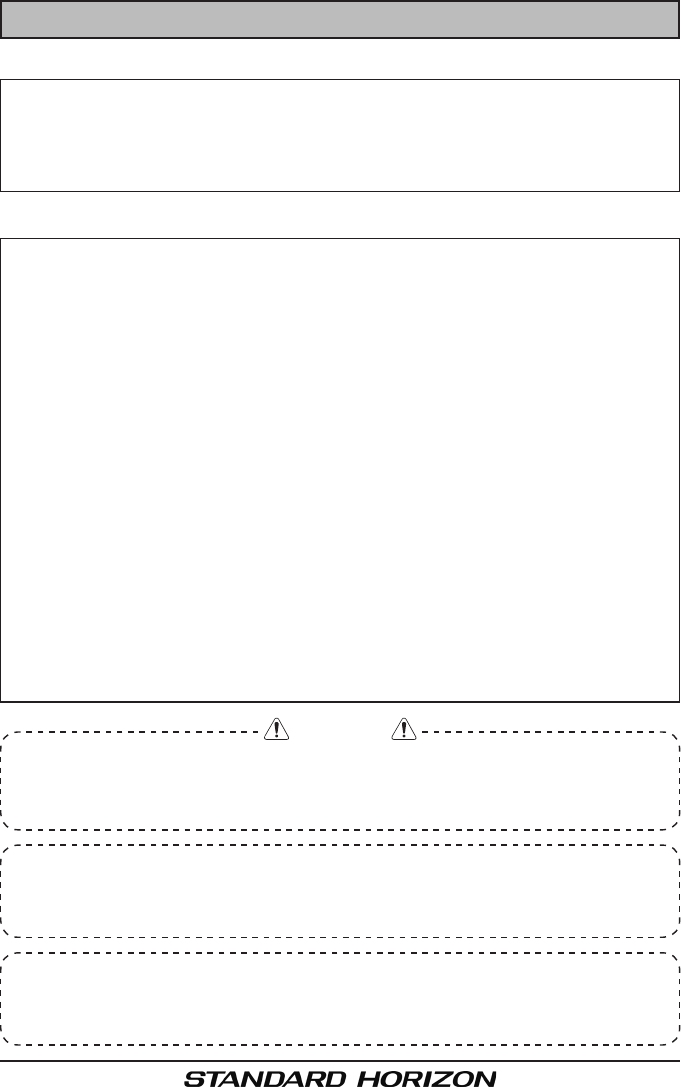
Page 43HX300
This device complies with part 15 of the FCC rules. Operation is sub-
ject to the condition that this device does not cause harmful interfer-
ence.
Part 15.21: Changes or modifications to this device not expressly
approved by Vertex Standard could void the User’s authorization to
operate this device.
13. FCC NOTICE
NOTICE
Unauthorized changes or modications to this equipment may void
compliance with FCC Rules. Any change or modification must be
approved in writing by STANDARD HORIZON, a Marine Division of
VERTEX STANDARD.
NOTICE
This equipment has been tested and found to comply with the limits
for a Class B digital device, pursuant to Part 15 of the FCC Rules.
These limits are designed to provide reasonable protection against
harmful interference in a residential installation. This equipment
generates uses and can radiate radio frequency energy and, if not
installed and used in accordance with the instructions, may cause
harmful interference to radio communications. However, there is no
guarantee that interference will not occur in a particular installation. If
this equipment does cause harmful interference to radio or television
reception, which can be determined by turning the equipment off and
on, the user is encouraged to try to correct the interference by one or
more of the following measures:
Increase the separation between the equipment and receiver.
Connect the equipment into an outlet on a circuit different from that
to which the receiver is connected.
Consult the dealer or an experienced marine electronics techni-
cian for help.
CAUTION
This device is intended for general population use to satisfy FCC RX
exposure compliance. See section “1.2 SAFETY INFORMATION” for
specic operating requirement.
FCC ID: K6630493X20 / IC: 511B-303493X20
Vertex Standard Co.,Ltd.

HX300Page 44
Copyright 2011
VERTEX STANDARD CO., LTD.
All rights reserved.
No portion of this manual
may be reproduced
without the permission of
VERTEX STANDARD CO., LTD.
Printed in China
Marine Division of VERTEX STANDARD
US Headquarters
6125 Phyllis Drive, Cypress, California 90630, U.S.A.
FCC ID: K6630493X20 / IC: 511B-303493X20
Vertex Standard Co.,Ltd.